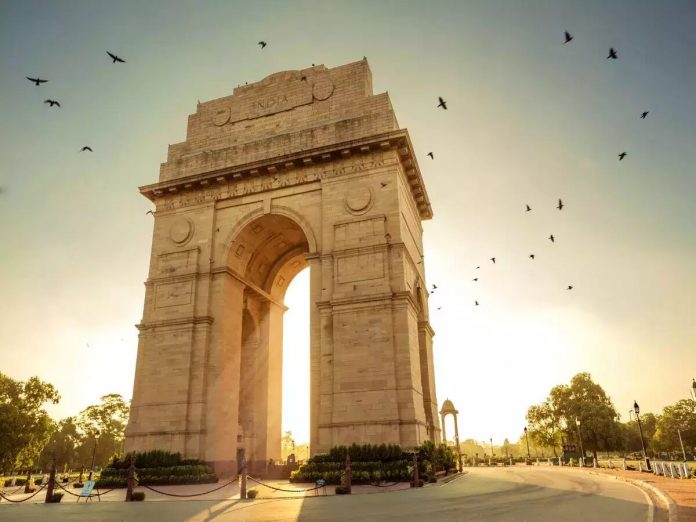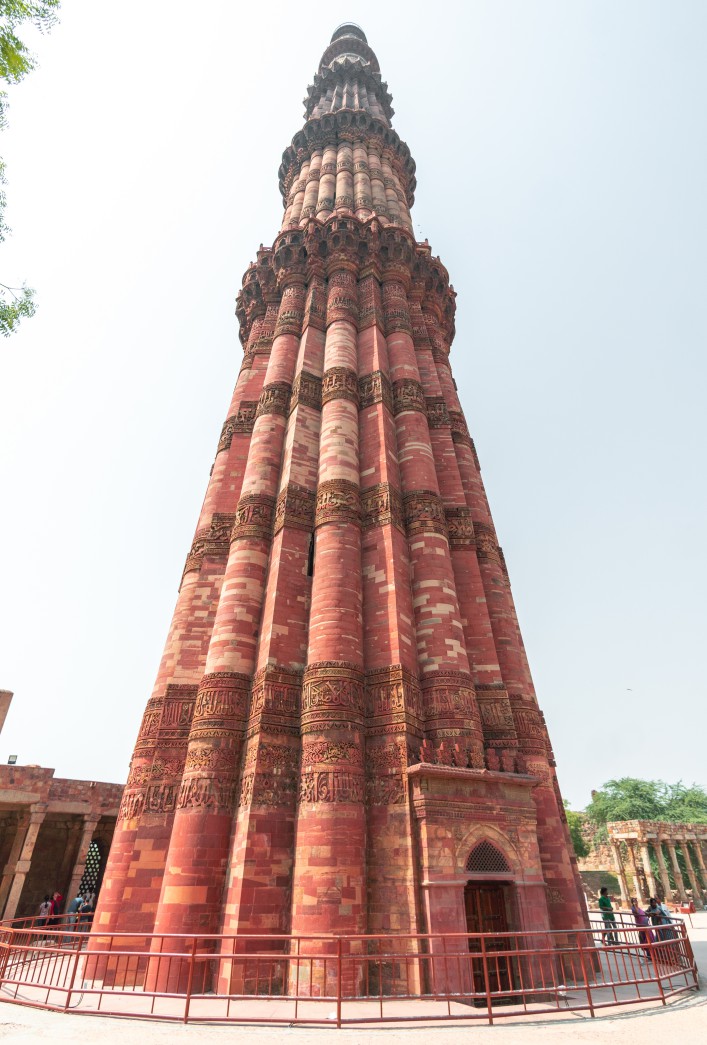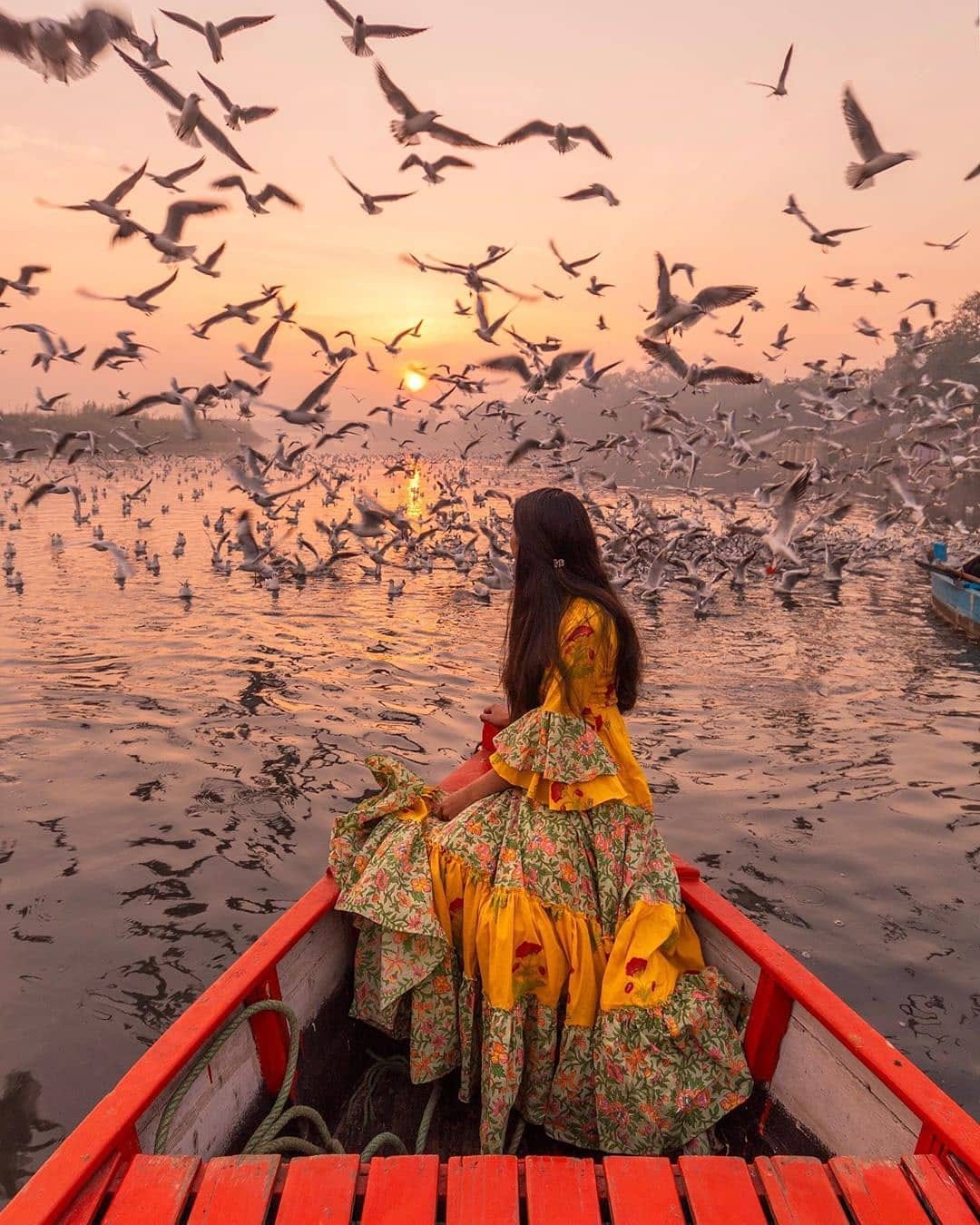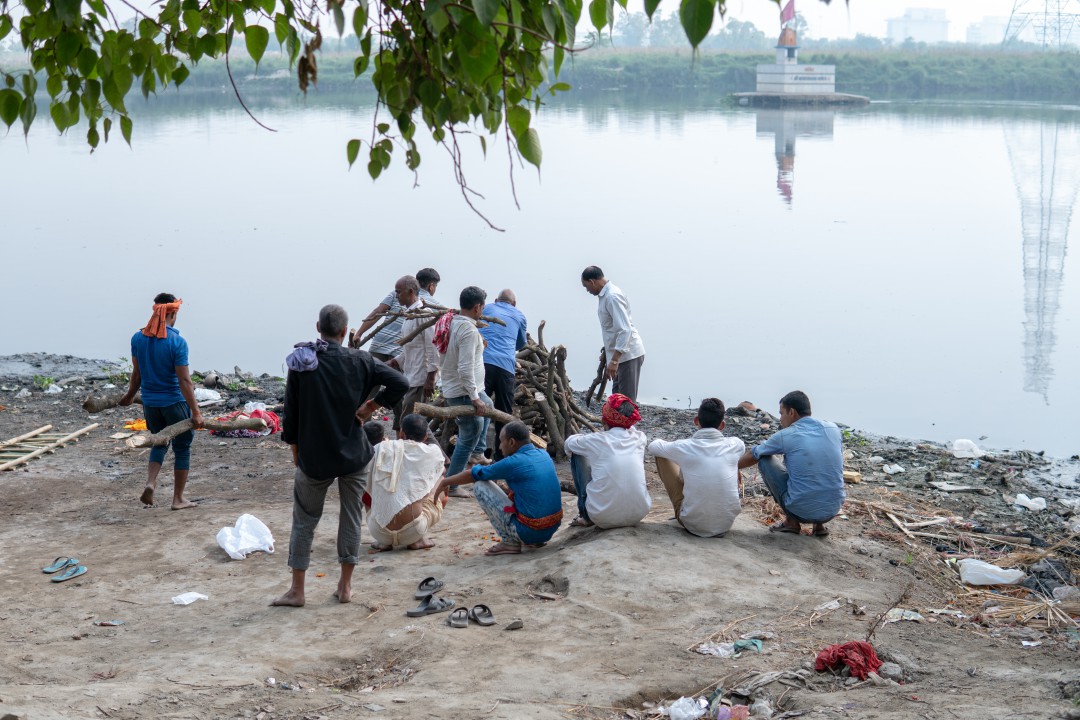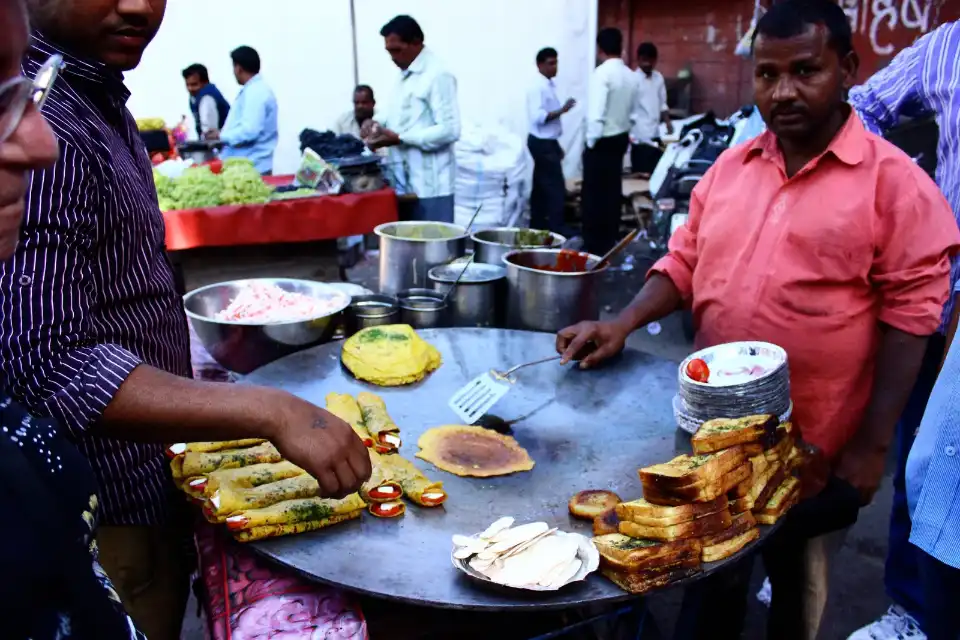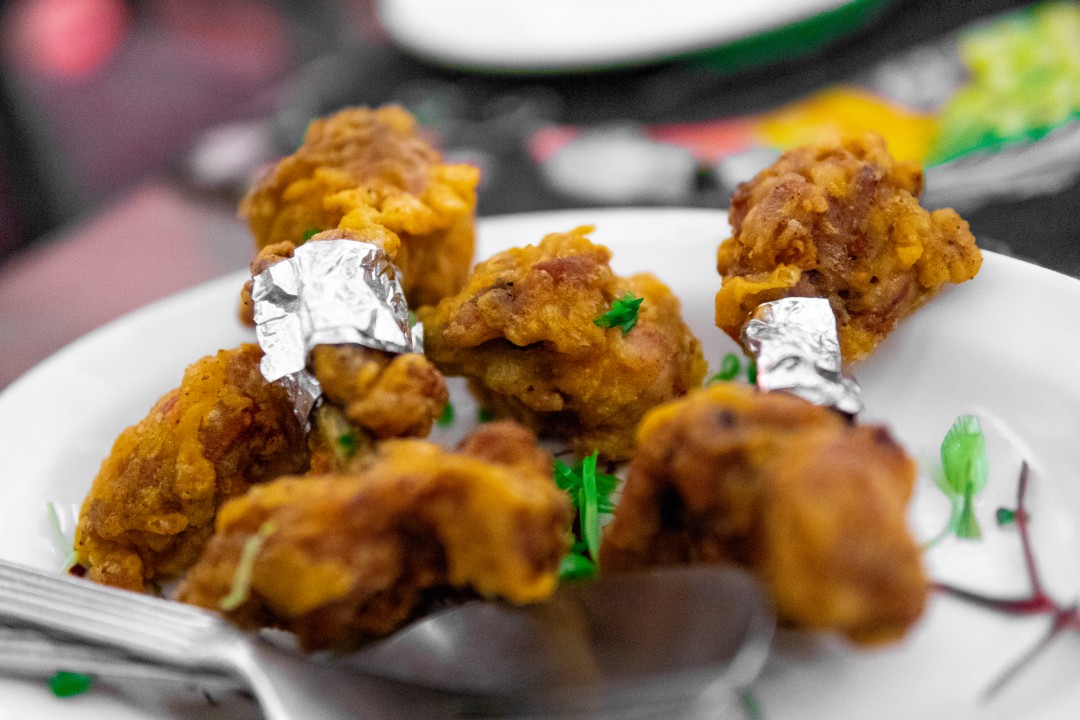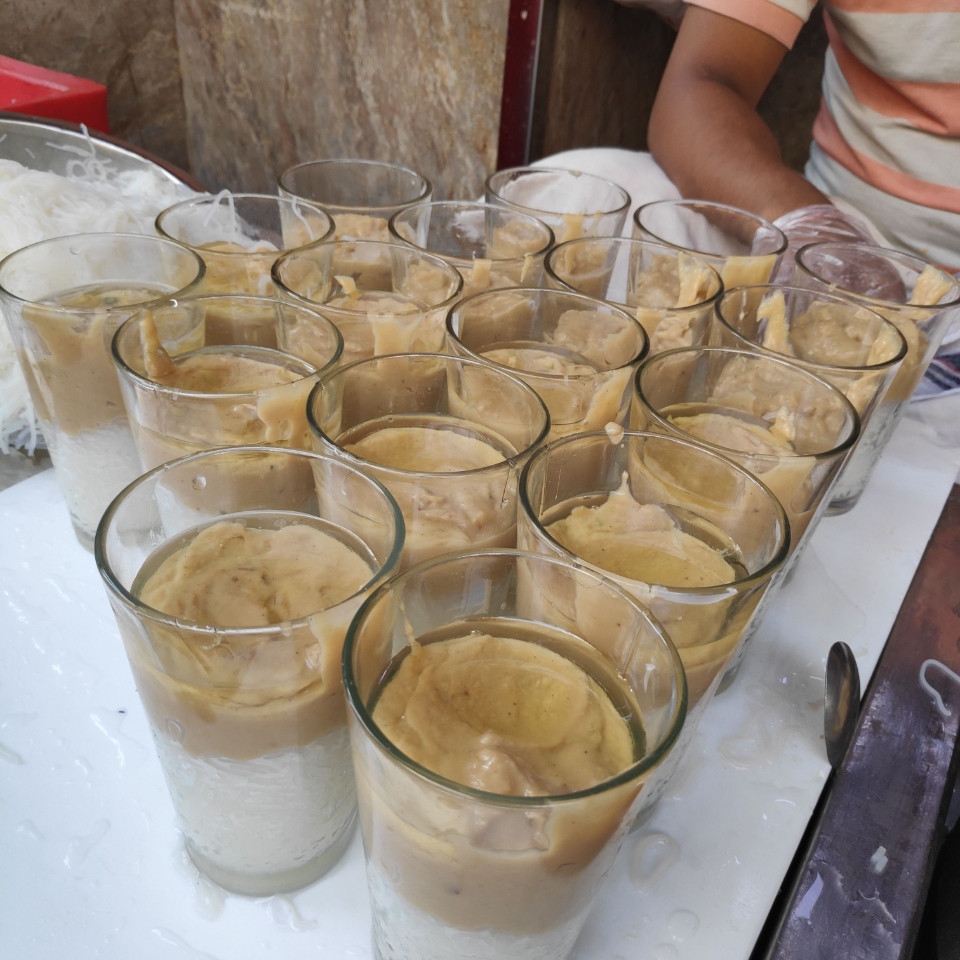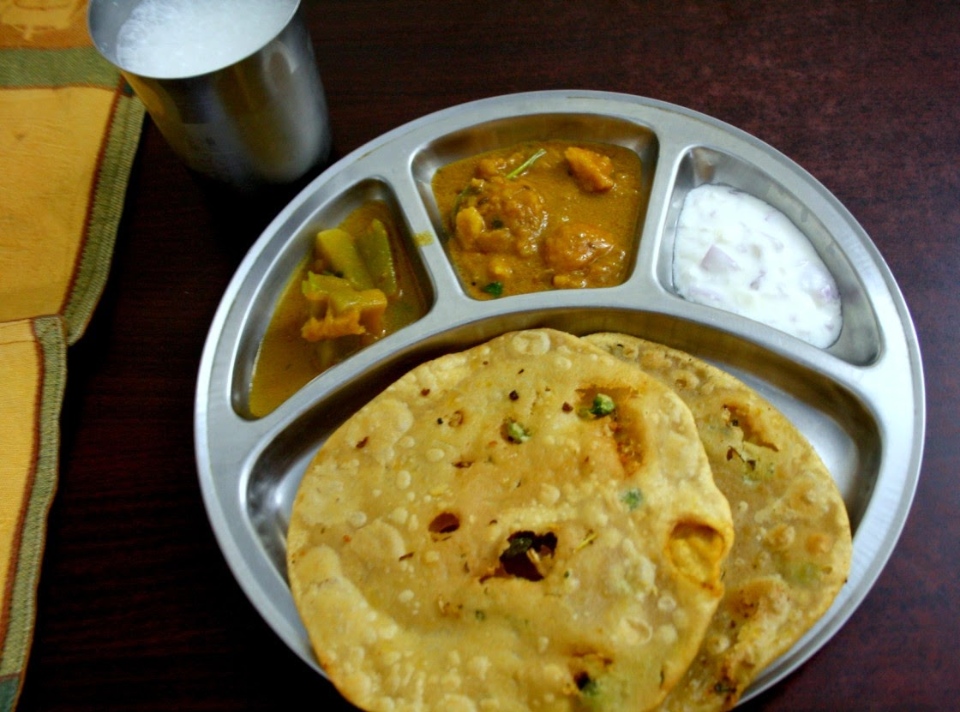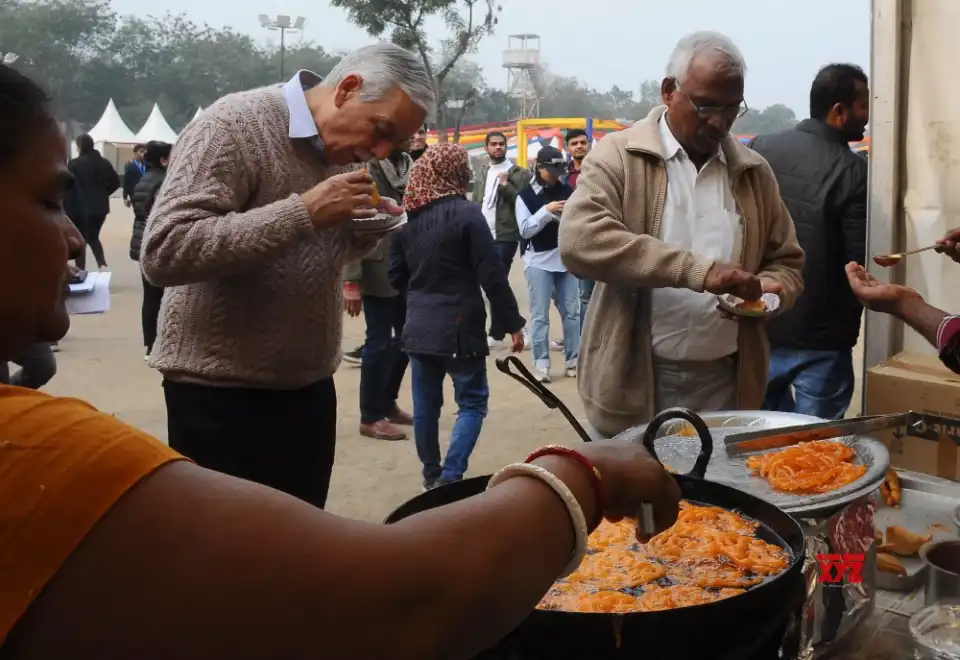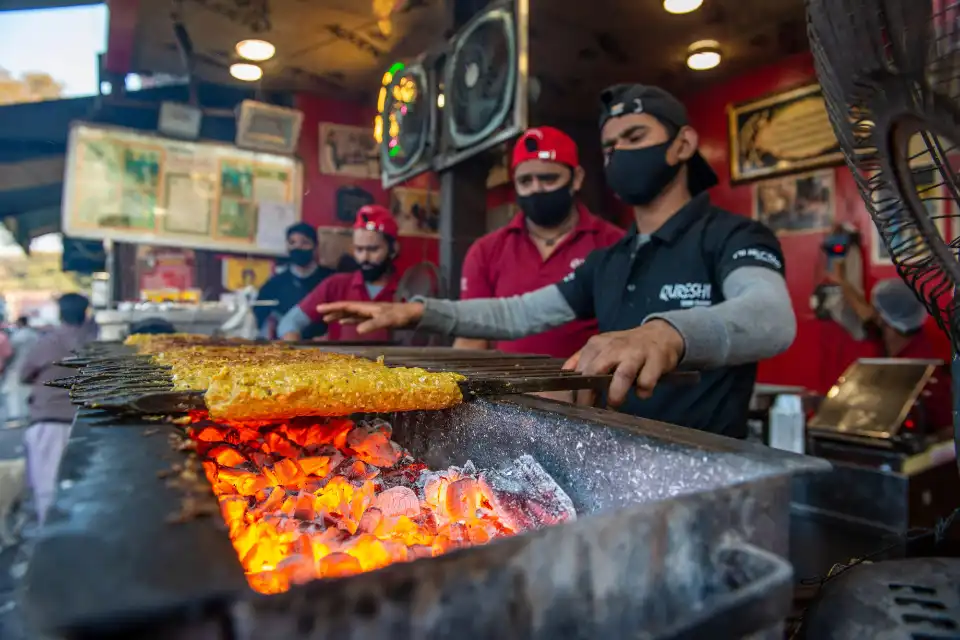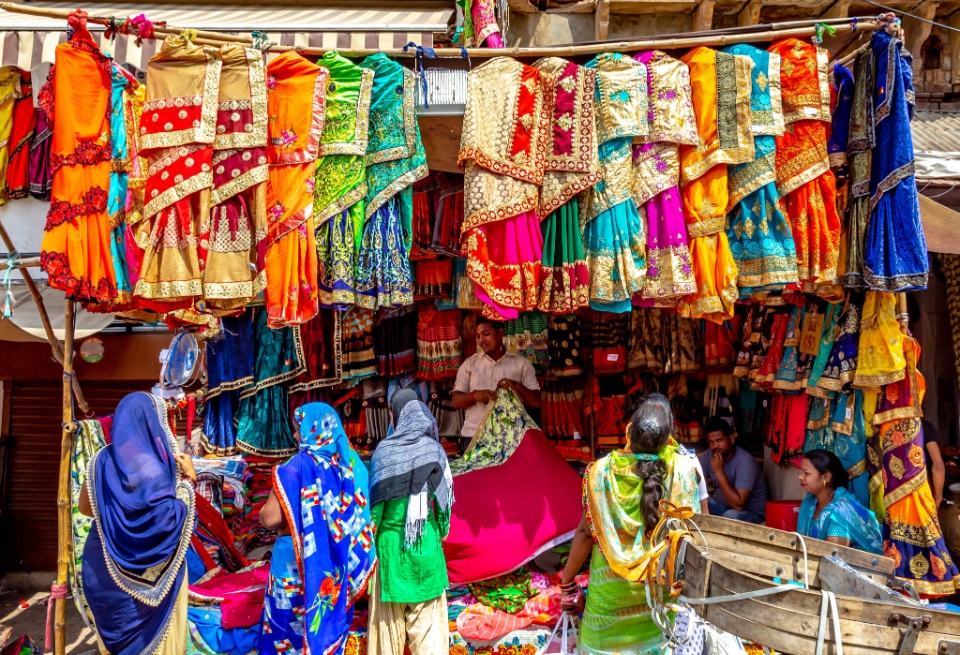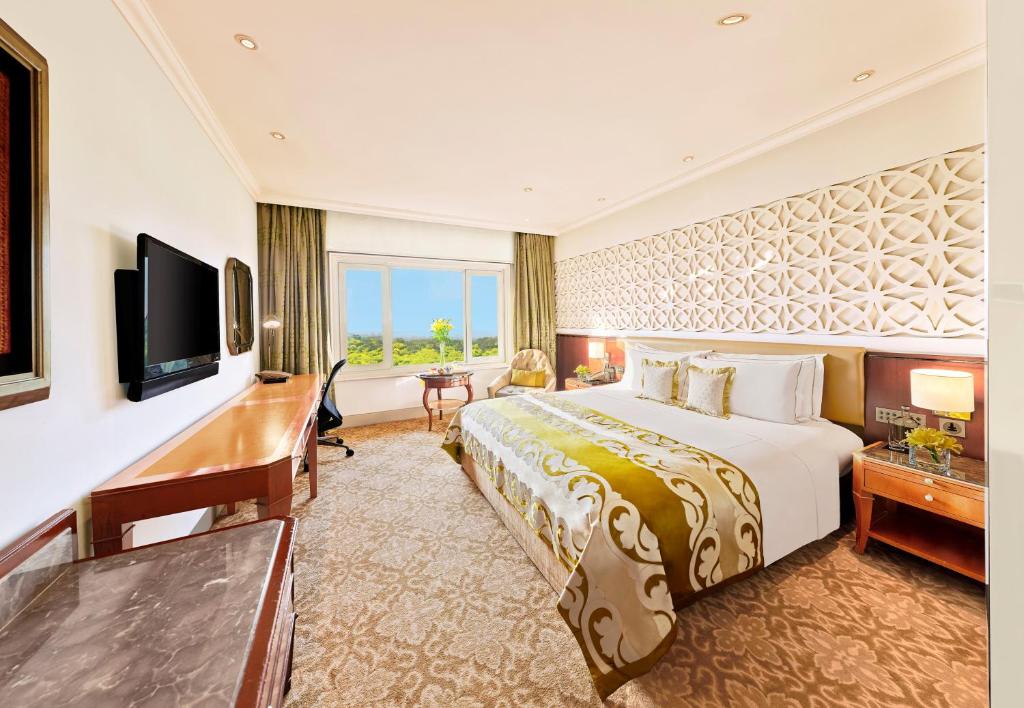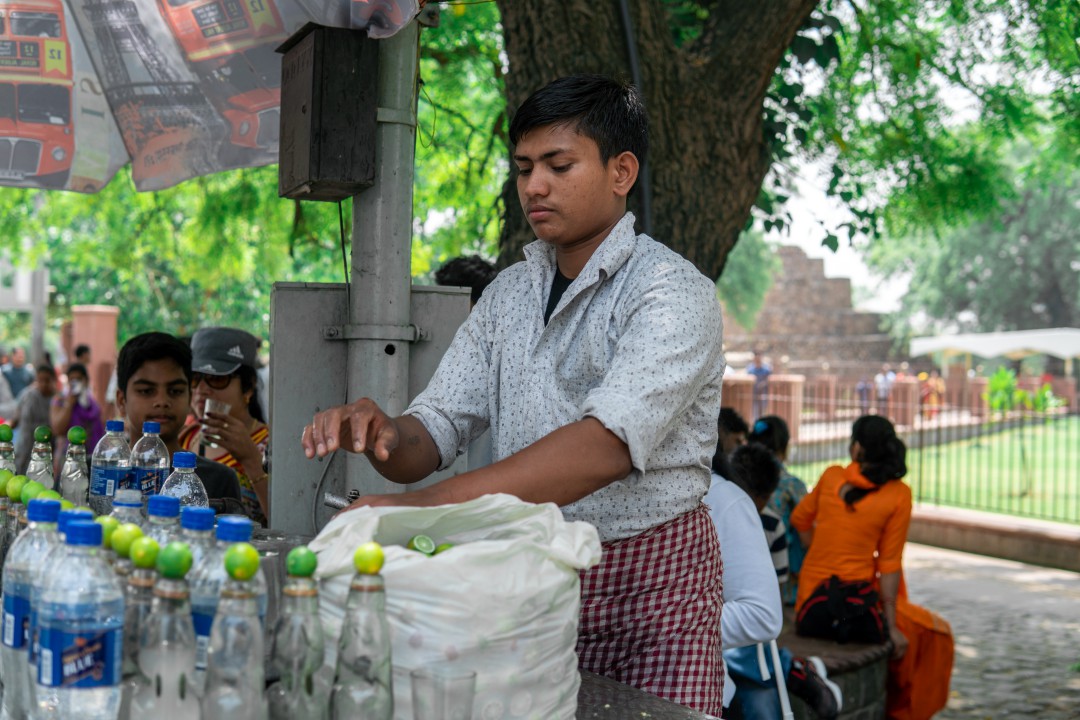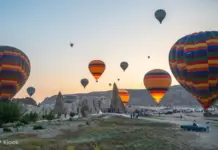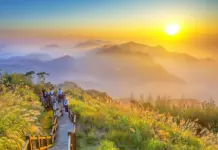Bustling, vibrant, crowded and colorful are what people often remember about Delhi – the Capital and miniature of India. With the unique culture and the interference of many different religious beliefs have created the unique attraction of Delhi. So, is Delhi worth visiting, how to visit Delhi, what to do in Delhi and how to plan a budget trip to Delhi for the first-time perfectly? Let’s check out our Delhi travel blog (Delhi blog, New Delhi blog, New Delhi travel blog) with the fullest Delhi travel guide (guide to Delhi, Delhi tourist guide, Delhi city guide, Delhi guide) from how to get to Delhi, best places to visit, best time to come, what to eat as well as top things to do in Delhi to help you maximize your trip as follows!
- The ULTIMATE Taj Mahal travel guide: How to get there, Tickets, Things to do, Tips & MORE
- Where to go & what to do in Varanasi? — 15+ places to visit & best things to do in Varanasi
- What to buy in India? — 29+ best gifts from India & best things to buy in India
- Leh Ladakh bike trip itinerary — How to spend 6 days in Ladakh by motorbike?
- Leh Ladakh bike trip blog — Ladakh bike trip guide & tips for first-timers


Located in the north of India, on the banks of the Yamuna River, the capital Delhi is the country’s second largest city after Mumbai and the first destination on almost every visitor’s journey to India.
Coming to Delhi, tourists are often overwhelmed by the excitement and bustle, by the unique arts and crafts, and by magnificent works and monuments. Delhi also attracts a large number of tourists thanks to the intersection of many cultures, festivals, rituals of each religion and many delicious dishes from all regions of the country converge.
Overview of Delhi (#new delhi travel blog)
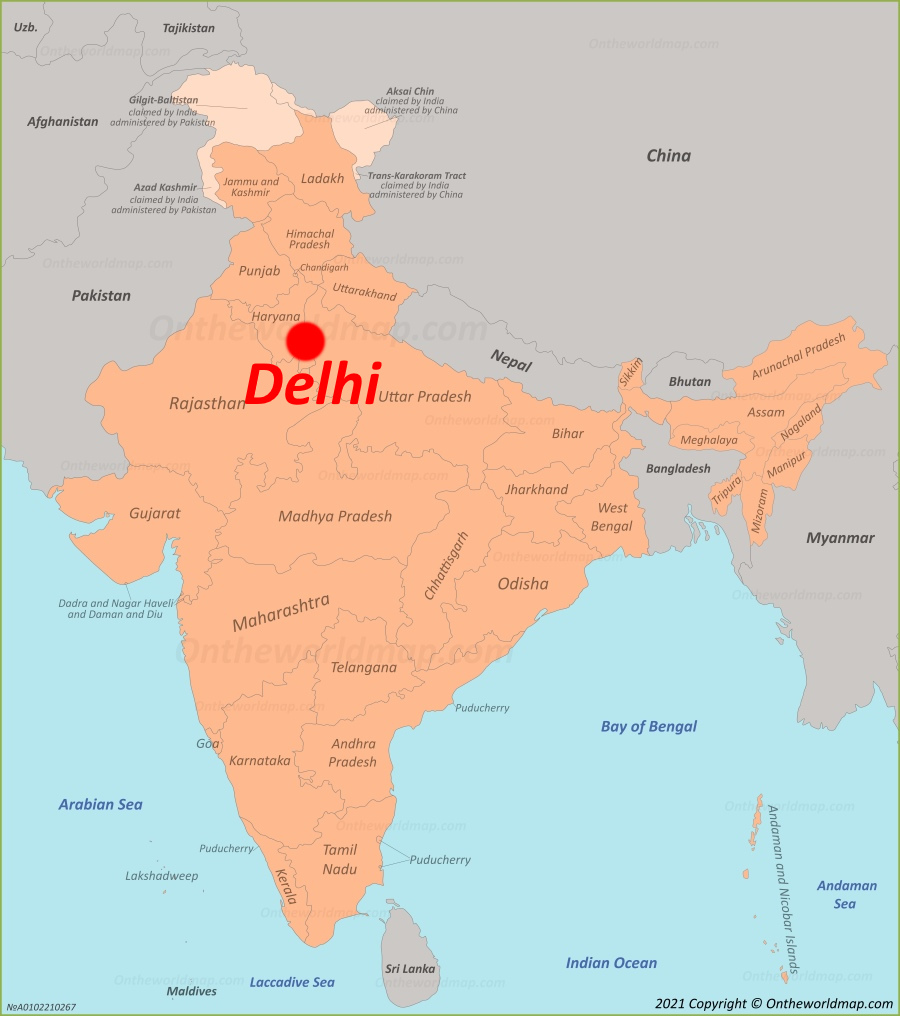
New Delhi is the capital of India, located in Northern India, built on the right bank of the Yamuna River, near the foot of the Aravali Range, at an altitude of 216m. New Delhi is the first destination of most tourists who want to travel to India because Indira Gandhi International Airport is one of the gateway airports of India.
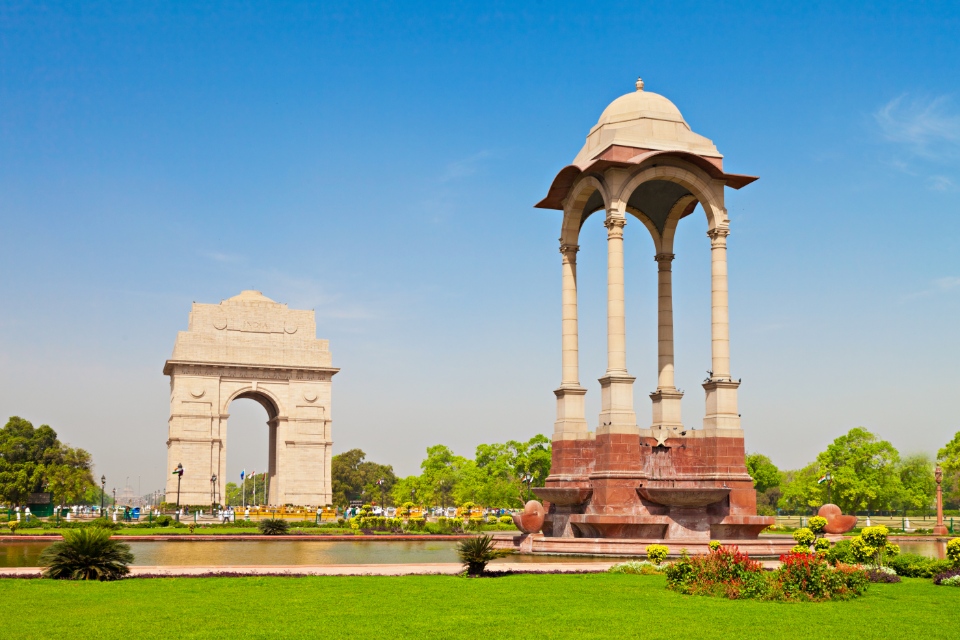
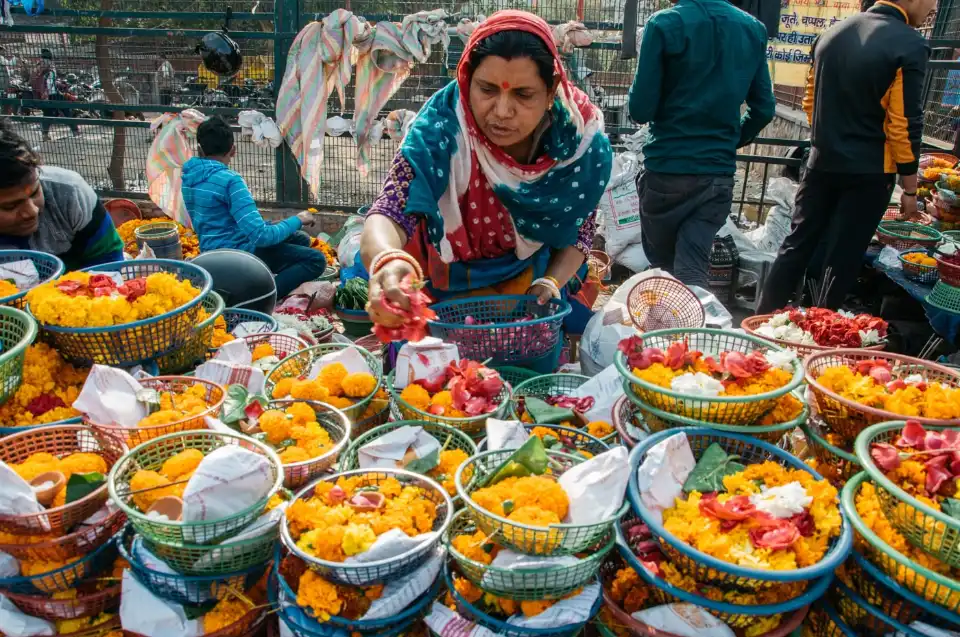
Delhi is recognized as the National Capital Territory of Delhi (NCT), a city and union territory (administrative division) of India. It includes New Delhi, which is not a city, but an inner-city district within Delhi. Although it is not considered a city, New Delhi is considered the capital of India and is the seat of all three branches of government.
Delhi India consists of two main parts, Old Delhi (with the center is Red Fort) and New Delhi (center is Connaught Place). Separating these two areas is the ancient Yamuna River, one of the most sacred rivers in Hinduism.
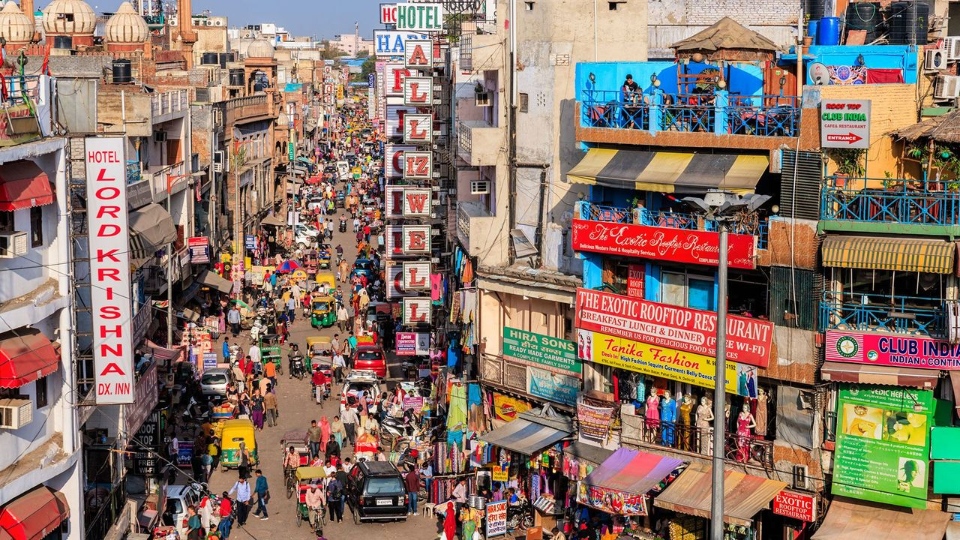
This city does not attract tourists by its natural landscape like many other cities in India, but coming here, visitors will be able to visit a lot of cultural and historical sites because this is a city with long history. There are many hundreds of years old relics, ruins, historic sites that are still left to this day.
Historically, Delhi is one of the most important cities in India, serving as an important political, commercial and cultural center throughout its long history. It is one of the oldest cities in the world and is believed to have been continuously inhabited since the 6th century BC.
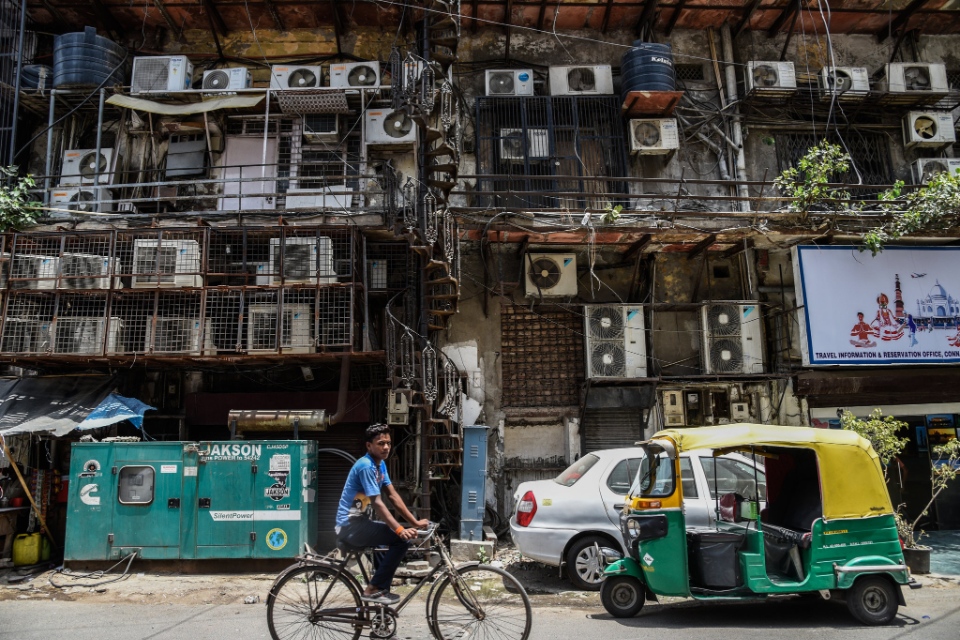

Apart from being the capital of the nation, it is also the second most populous city in India today and the second richest after Mumbai. It has an urban population of over 33 (Metro Area Population) million with an estimated 18 billionaires and 23,000 millionaires.

When to come? (#new delhi travel blog)
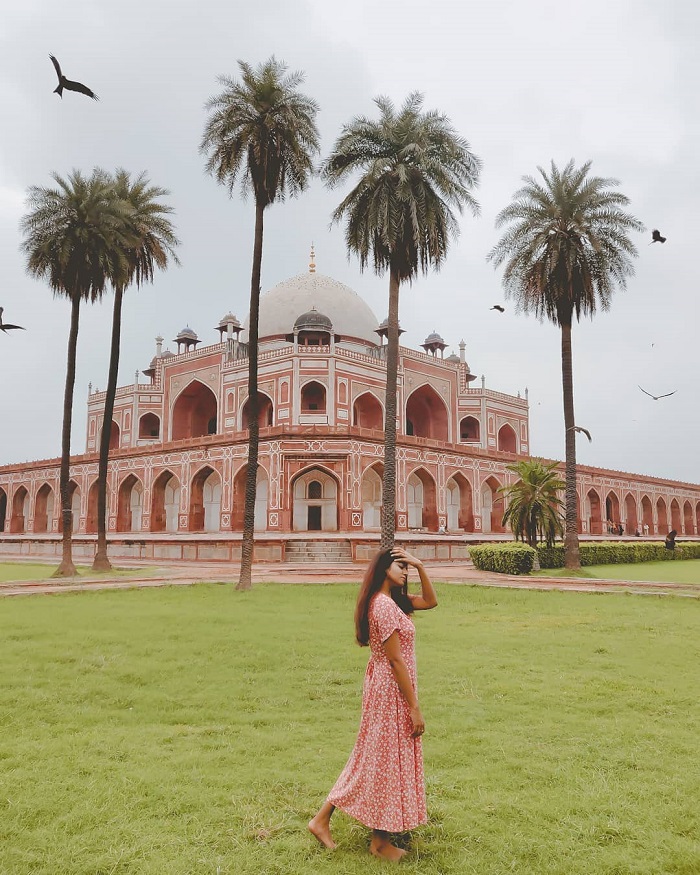
Delhi has a strong monsoon climate with sweltering hot and rainy summers and quite cold and dry winters. The average temperature in July is 31 degrees Celsius, January is 14.2 degrees Celsius. So the most suitable time to travel to Delhi is in October to November. This is the autumn time of New Delhi, so the weather is cool and comfortable, suitable for outdoor trips. However, you can also choose to visit New Delhi at your favorite time.
October-March: Autumn and spring are the best times to visit Delhi. Winter is also good, although it can be cold in the mornings and evenings, remember to bring warm clothes. If you like festivals, then October-November is a great time to go. Diwali festival is held around late October to mid-November and is one of the biggest and most famous festivals in Delhi.
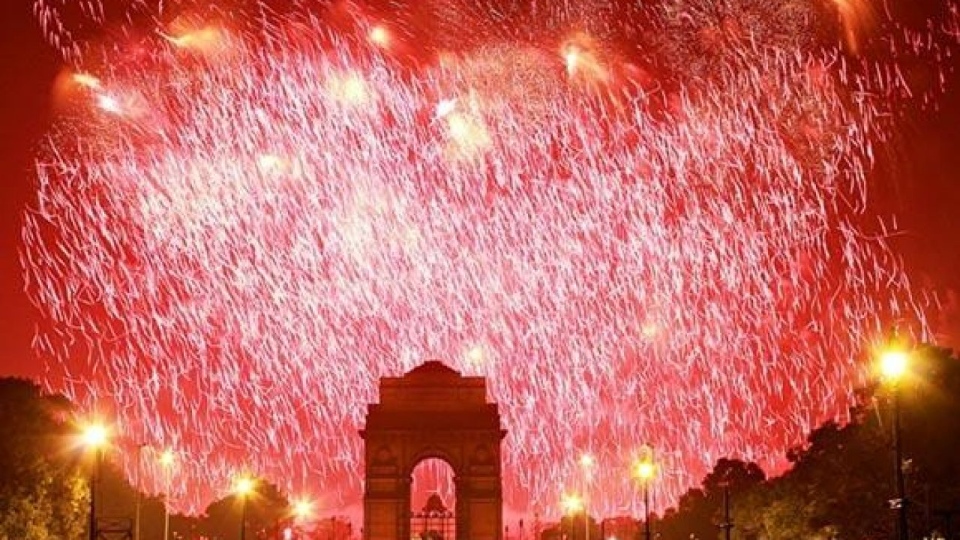
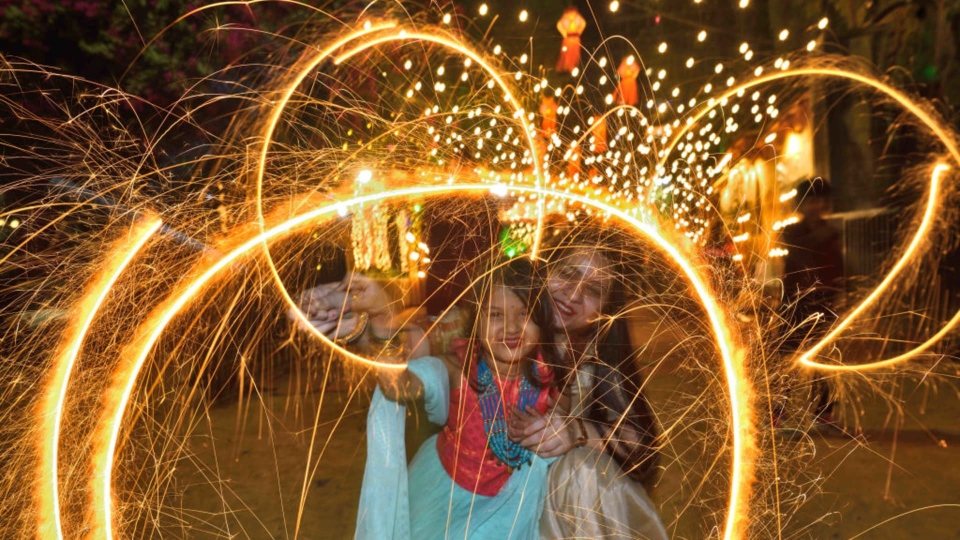
From April to June: Summer is hot with hot sun and hot dry winds blowing from the desert. Temperatures can soar as high as 43 degrees Celsius, and is probably not the best time to go.
July – September: This is the monsoon season in Delhi with August being the rainiest month. At the end of September, the weather is quite pleasant, Delhi in the rainy season is quite beautiful. People definitely prefer it over the sweltering heat of summer.
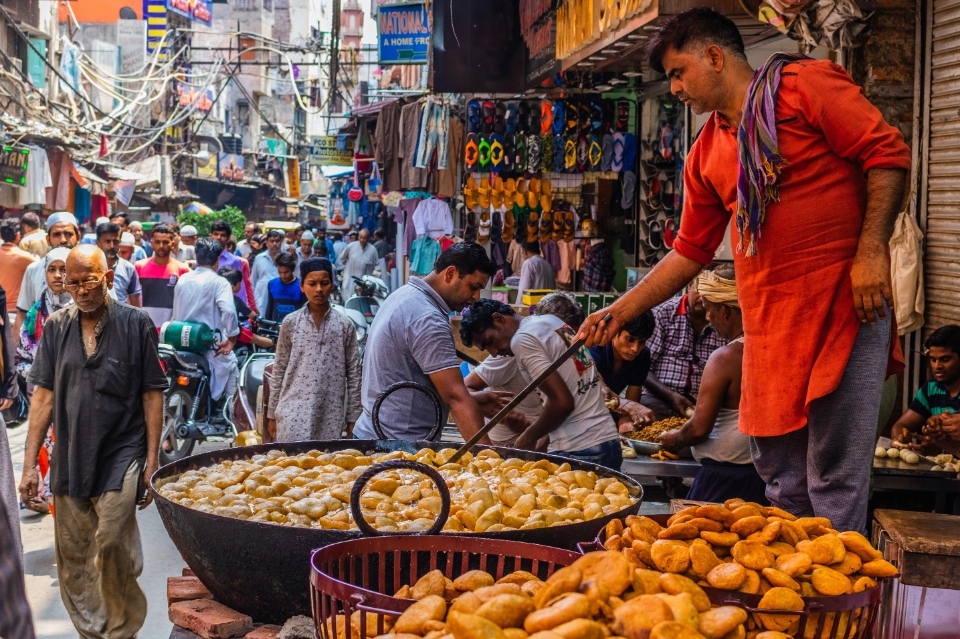
From October to November: Most tourists often choose to come to the city during this period due to the cool, pleasant autumn weather, which is very suitable for excursions.
From December to February: The weather turns to winter. Low temperature drop, about 7 degrees Celsius to 23 degrees Celsius.
How to get to New Delhi? (#delhi travel blog)
In New Delhi, there is Indira Gandhi International Airport which is one of the main international and domestic gateway airports of India. So the most convenient and fastest means of transportation to Delhi is definitely by airplane. Especially when Vietnam has 2 big airlines, Vietjet and Vietnam Airlines, operating direct flights to New Delhi from 2 big airports, Noi Bai Airport and Tan Son Nhat Airport with the price of more than $150/way.

Getting from the airport to the city center (#new delhi travel blog)
Indira Gandhi International Airport is about 23 km southwest of central Delhi. Usually, there are three ways to getting to the city center that you can refer to:
- Taxi: You can book a prepaid taxi at the counter located outside the arrivals hall of the international terminal at Indira Gandhi. This is a taxi counter operated by the Delhi traffic police, so you can be assured of the service. Just pay for the specified destination at the counter, then you will receive a ticket. Give this ticket to the driver.
- Subway: You take the Airport Express line to get into the city center.
- Bus: The bus will stop at most major hotels on the main road with the last stop being Ajmeri Gate, near New Delhi railway station. The fare is 50 rupees, plus 10 rupees if you bring large luggage.
Transportation in New Delhi (#delhi blog)
To get around the city of New Delhi, you will have many options such as subway, bus, auto rickshaw, or taxi and self-driving car.
Metro
The Delhi metro has improved significantly in recent years. The rapid transit cars bring locals and tourists around the city seamlessly, and the Airport Metro line operating a route from Delhi airport. You can buy a single ticket or a metro day pass for 150 rupees or a three day pass for 300 rupees.
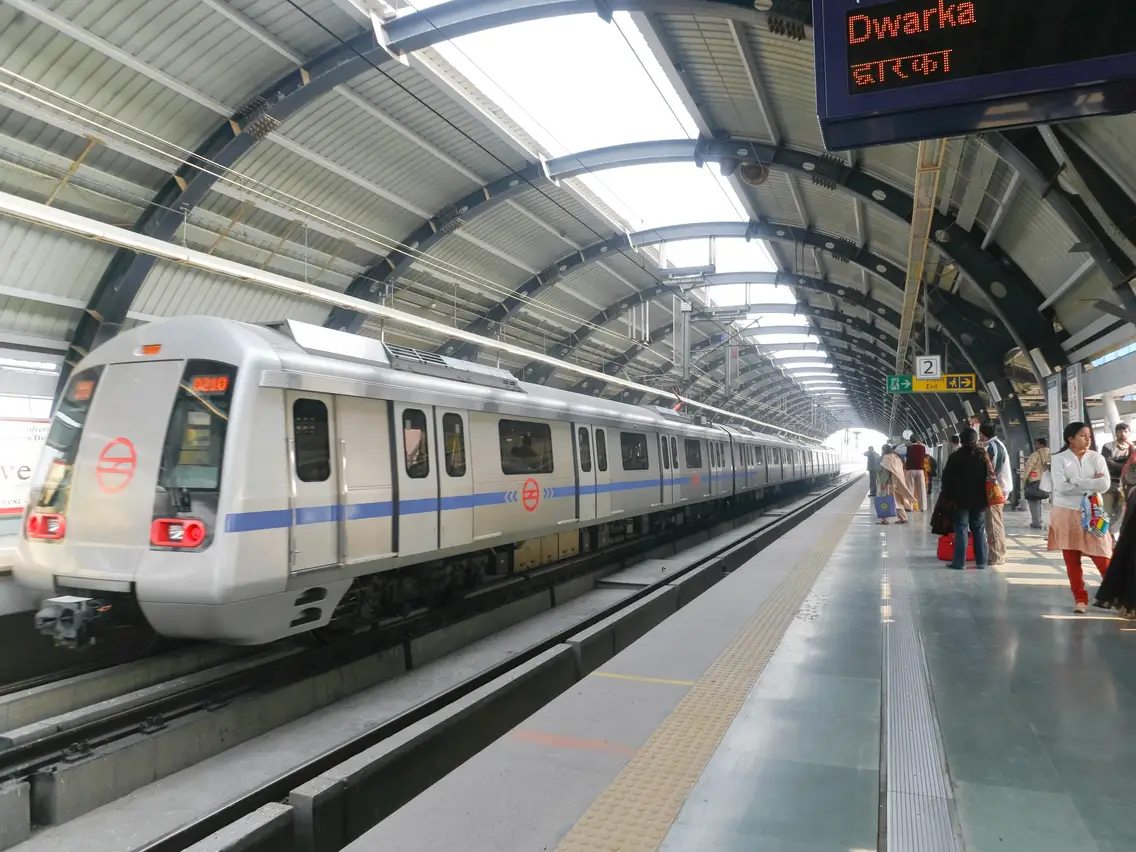
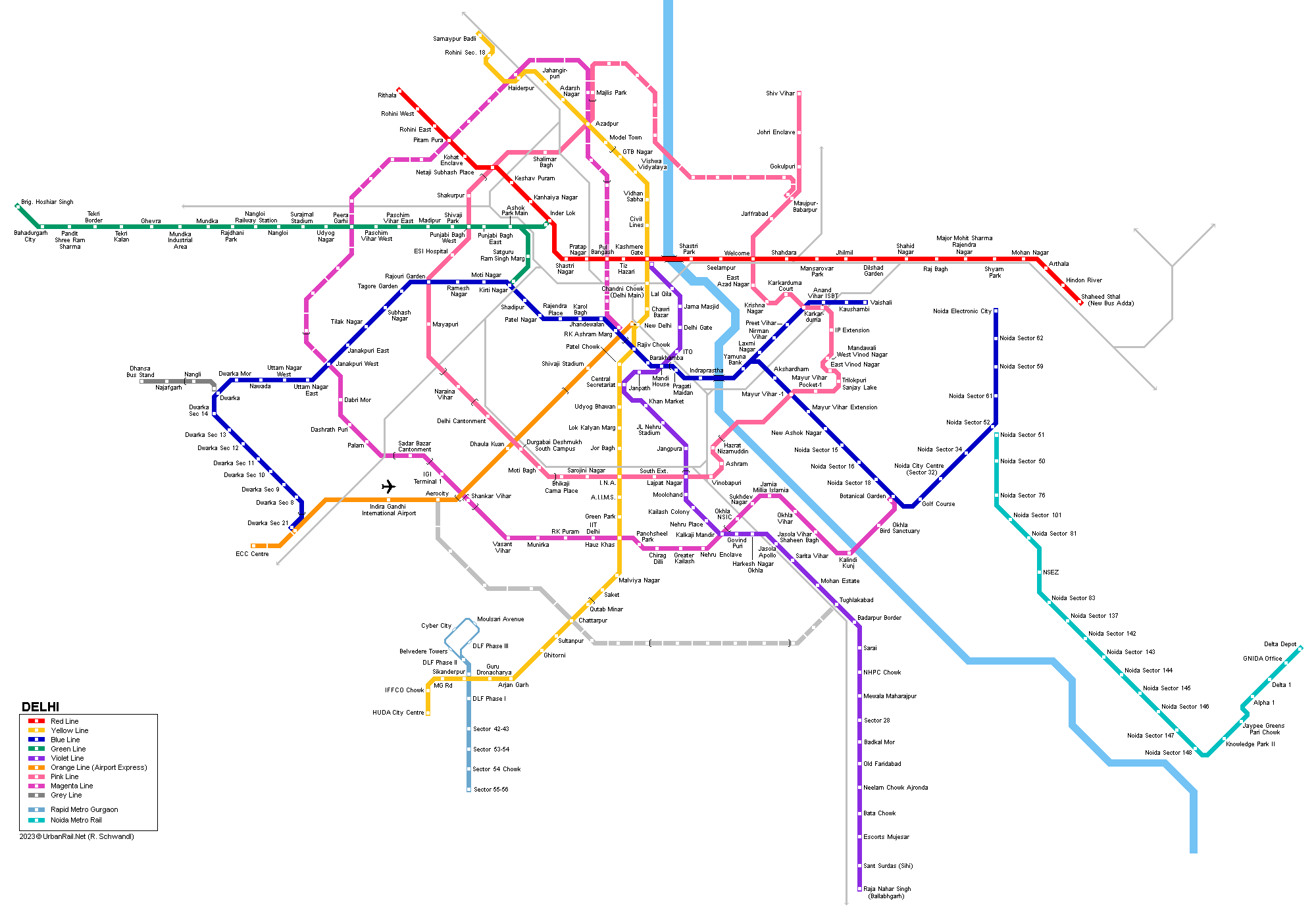
It is the most convenient means of transportation in New Delhi and it is one of the largest metro systems in the world. The Delhi Metro system has completed phase 2, consisting of 9 lines with a total length of 193.2 km and 208 trains.. So to get around Delhi, the subway is the first choice.
- Travel Card: You can buy a travel card for 150 rupees.
- Tourist Card: You can also use this card because this card does not limit train lines except Airport Express. The one-day pass costs 200 rupees, and the three-day pass costs 500 rupees.
- Token: Single ticket for each trip, in the shape of a plastic coin. Tickets are only valid for the day, priced from 10-60 rupees.
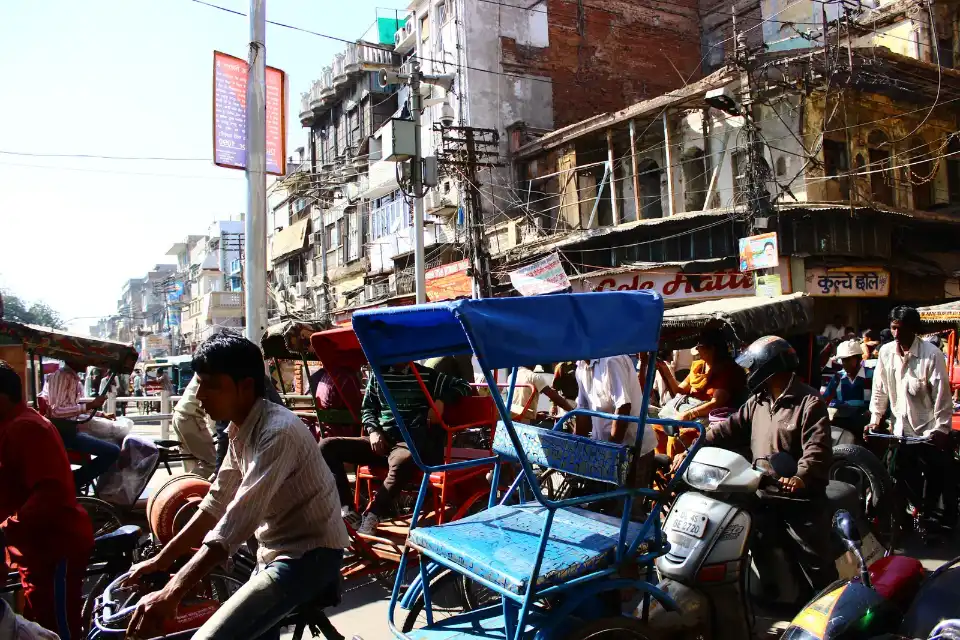
Bus (#delhi blog)
The city is served by DTC (Delhi Transport Corporation) buses. Buses are not always air conditioned and are quite crowded. Fares range from 5 to 25 rupees depending on the length of the trip. There are around 700 routes and 3,000 public buses in Delhi to choose from. This is a cheap means of transport used by Indians.
Auto rickshaw

Also a popular means of transportation in Delhi, an auto rickshaw is a three-wheeled vehicle with an engine similar to a tuk tuk in Thailand.
You can see auto rickshaw everywhere and it can take you to any corner of the city. With a travel distance of less than 30 km, you should choose this vehicle. The price is about 50 rupees for 5-6 km.
Taxi
You can also choose a taxi as a means of transportation, you can order a taxi through the taxi station or through the hotel. Although the car has a meter, do not forget to negotiate the price of the car in advance with the driver. In addition, if you travel between 11pm and 5am, you will have to pay an additional 5% surcharge.
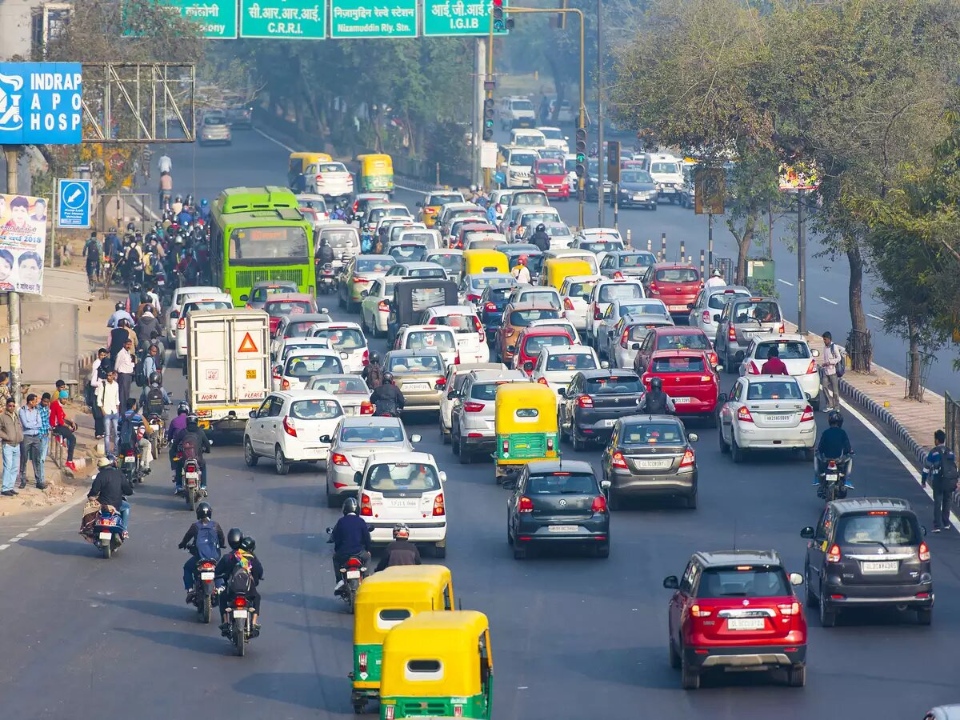
Self-driving car
Self-driving cars in New Delhi have a duration of 8 hours / day and are calculated according to the kilometer limit per day. To use a self-driving car here, you need a driver’s license and a certificate of group 3 insurance. Most major hotels provide car rental services upon request. However, the streets in Delhi India are quite crowded and the way to go is also different, so visitors should not choose this way of traveling if they are not familiar with the roads and traffic here.
However, we do not recommend this option because the traffic in New Delhi at rush hour is quite chaotic and if you are not used to moving to the left, it will be difficult to control the car here.
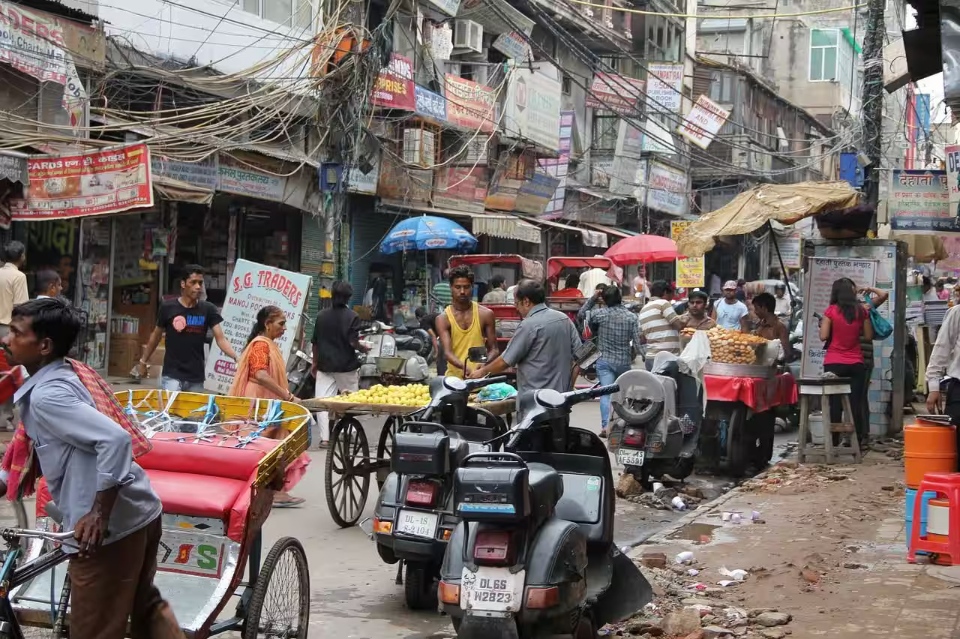
Tips: When I went, I found Grab and Ola to be the most convenient, not afraid of get ripoff and fast – but the price is a bit more expensive. If you want to save money, you can take the train, which will be very cheap but crowded and takes time to learn and transfer. Especially if you are a woman, you should avoid this vehicle.
Where to go and what to do in Dehli? (#new delhi travel guide)
Old Delhi

The old capital, just like in Hanoi, we have the old town – this is the center of the capital since the old days before expanding to new areas like today, which are re-planned, wider and more beautiful. The big difference between Old Delhi and the old town in Hanoi is that the Old Town in New Delhi is not ancient, rich in ancient culture, but dusty, messy and dirty.

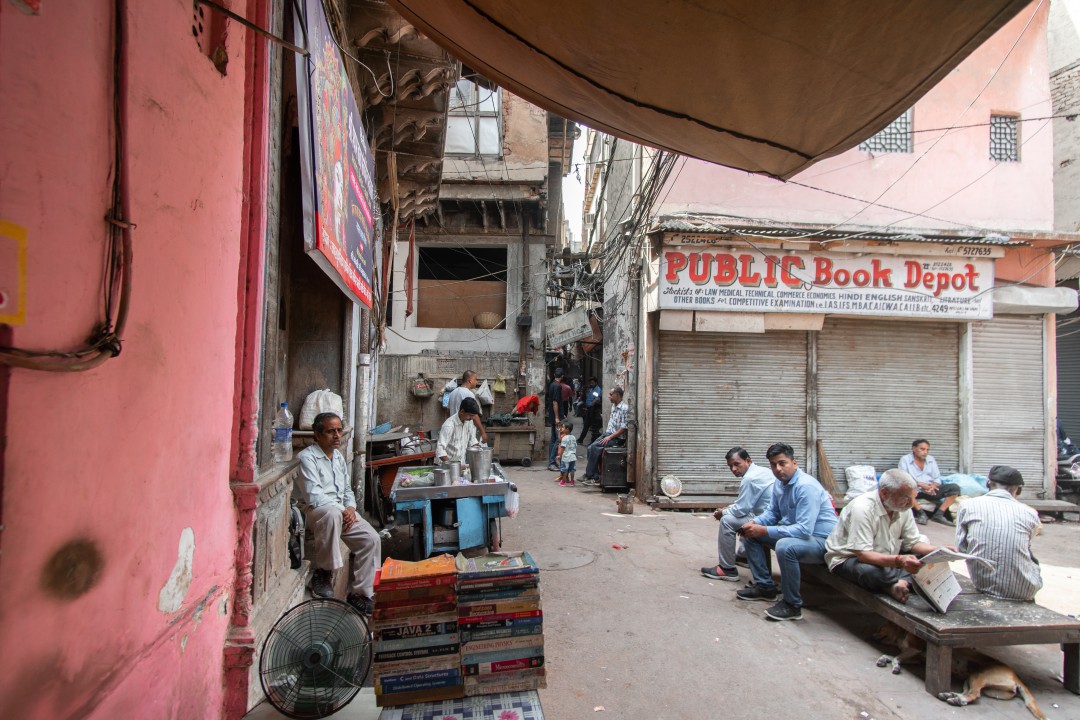
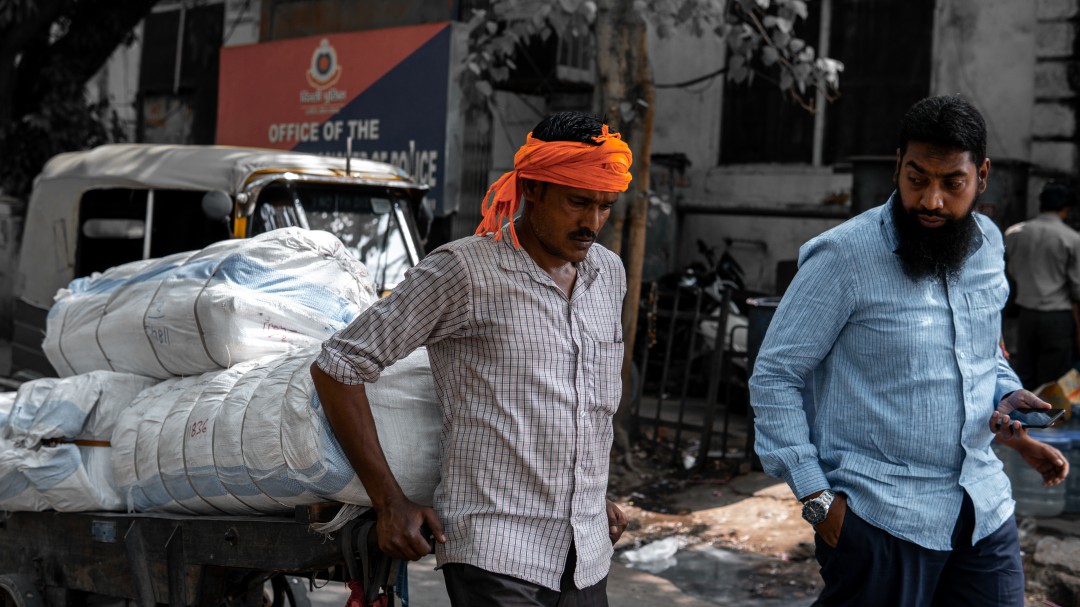
Red Fort (Lal Quila) (#new delhi travel guide)
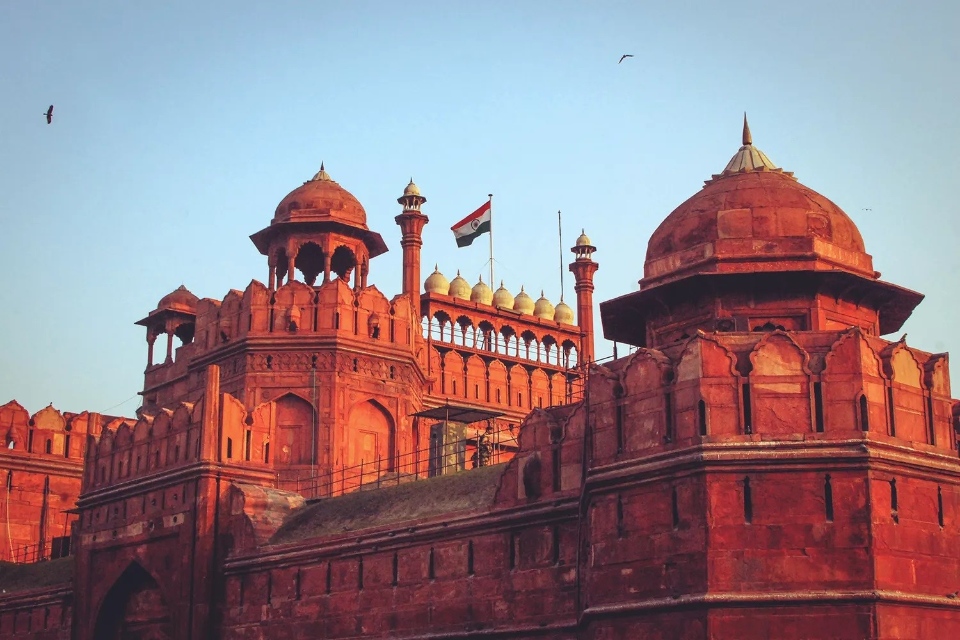
Built by emperor Shah Jahan in 1638, this is a massive fortress with an area of about half a square kilometer with a wall extending over 2 km and 18 m high. This complex includes items such as Diwan-i-Am (the royal palace, where the king’s throne stone is placed), Diwan-i-Khas (the secret palace, where the king receives special guests), Khas Mahal ( the emperor’s main residence), Rang Mahal (the residence of the emperor’s queen consort), Mumtaz Mahal (6 rooms for the emperor’s harem)…
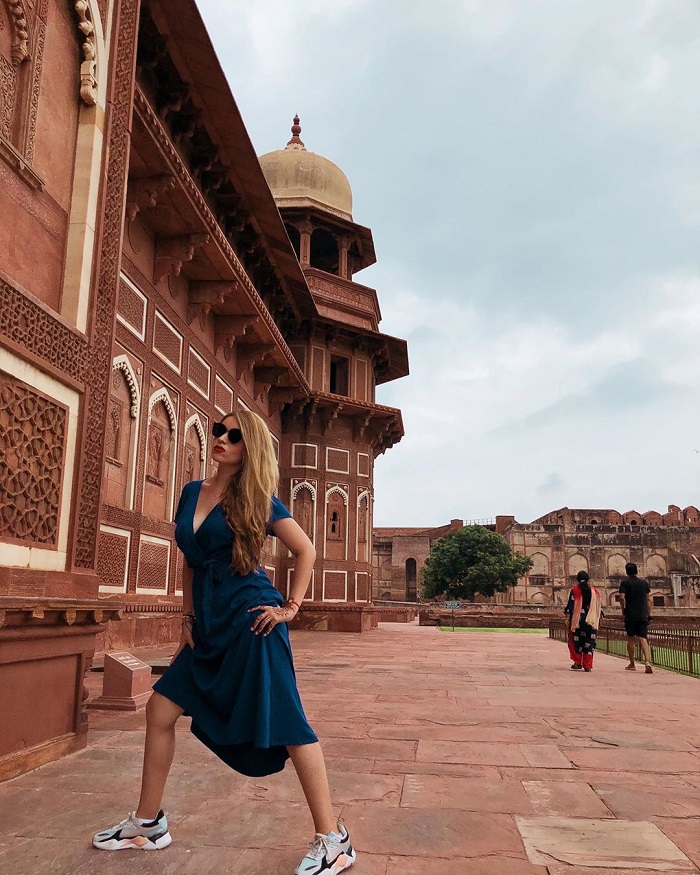
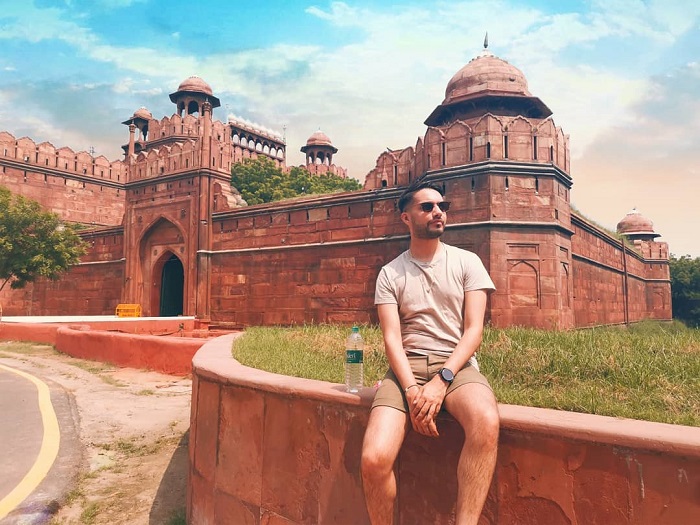
A UNESCO World Heritage Site, Delhi’s famous Red Fort is a celebration of Mughal architecture. The fort was completed in the mid-1600s when Shah Jahan emperor moved the capital from Agra to Delhi.
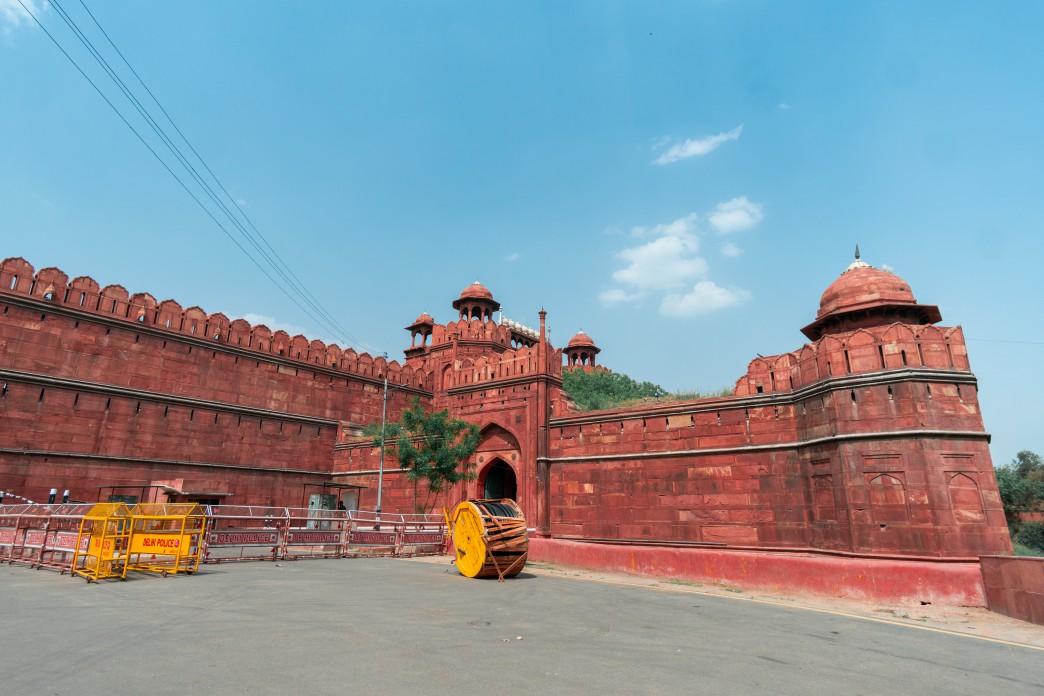
- Address: Netaji Subhash Marg, Lal Qila, Chandni Chowk, New Delhi, Delhi 110006, India
- Hours: Visit Red Fort from 9:30am to 4:30pm any day except Monday. Note: At 6pm there is a light and sound show, ticket price is 80 rupees/adult, 30 rupees/child.
Friday Mosque (Jama Masjid)
Jama Masjid is the largest mosque in India and one of the masterpieces of Emperor Shah Jahan, the great builder of the Mughal Empire. Built in the style of Persia and India, Jama Masjid stands out with its 54 m high Buland Darwaza (Victory Gate). Inside the premises is the tomb of the cleric Saikh Salim Chishti with detailed marble curtains famous for its sophistication.
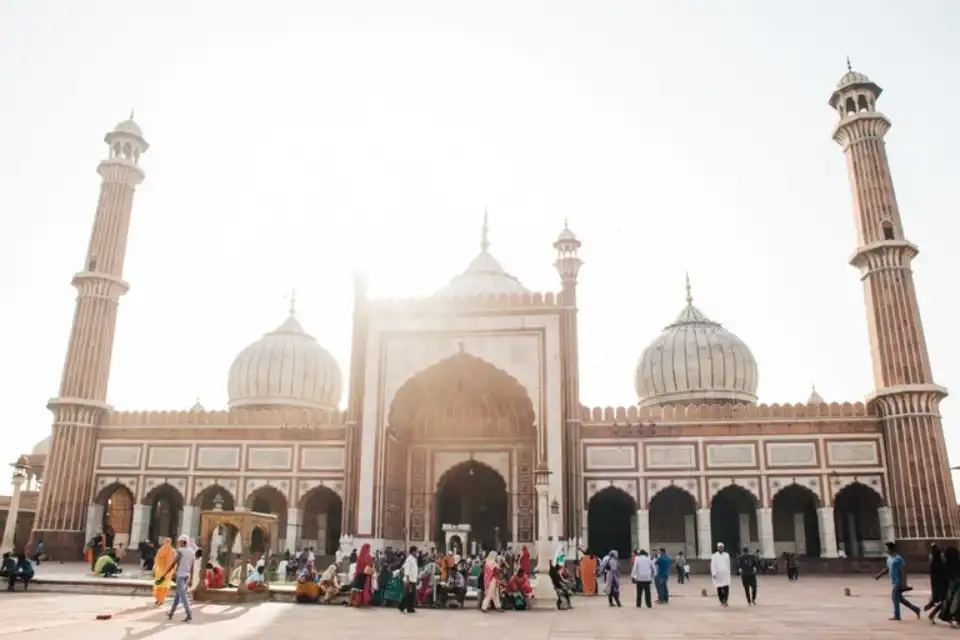
A very large courtyard, surrounded by a series of scrolls and with three gates located at the front of the prayer hall, provides the viewer with a sense of magical calm thanks to the harmony of arches and spaces. The yard can accommodate 25,000 people to worship with the 70m high red and white striped sandstone towers. Those who have the energy and passion to climb the 122 steps to the top will be rewarded with amazing views of Delhi from above.
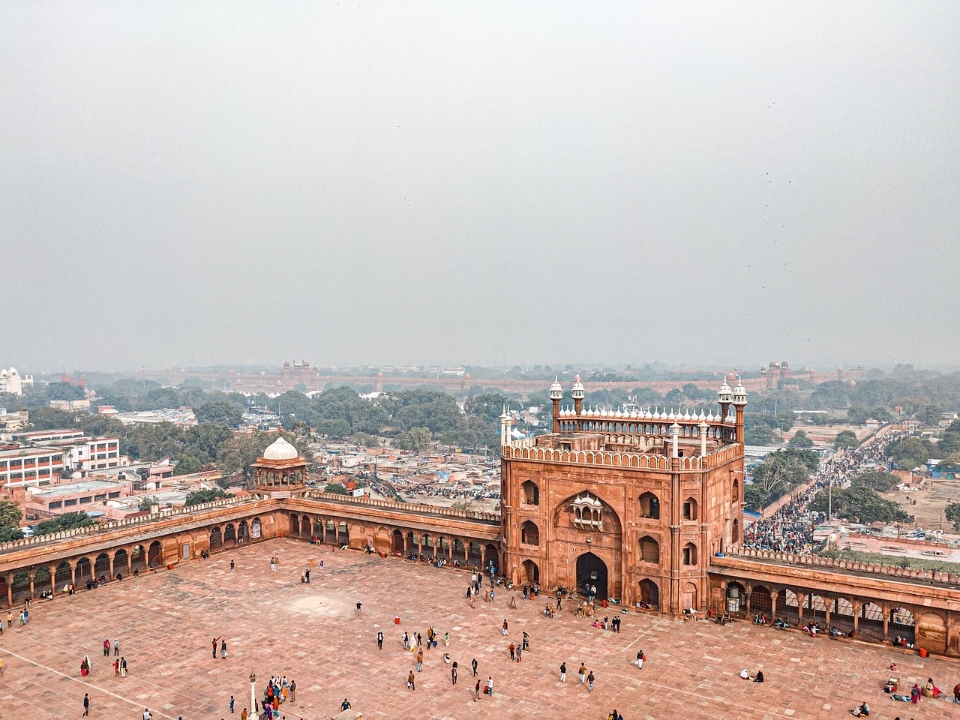
- Address: Meena Bazaar, Jama Masjid, Chandni Chowk, New Delhi, Delhi 110006.
- Nearest station: Opposite Red Fort, next to Chandni Chowk in Old Delhi.
Entrance fee: Free admission but must pay a camera fee of 300 rupees. - Opening hours: From 7am to 12pm and from 1:30pm to 6:30pm.
- Note: Not allowed to take pictures during prayer time. Remember to cover your shoulders and bare feet and do not wear shoes. Tourists enter through the main gate number 3.
Humayun’s Tomb
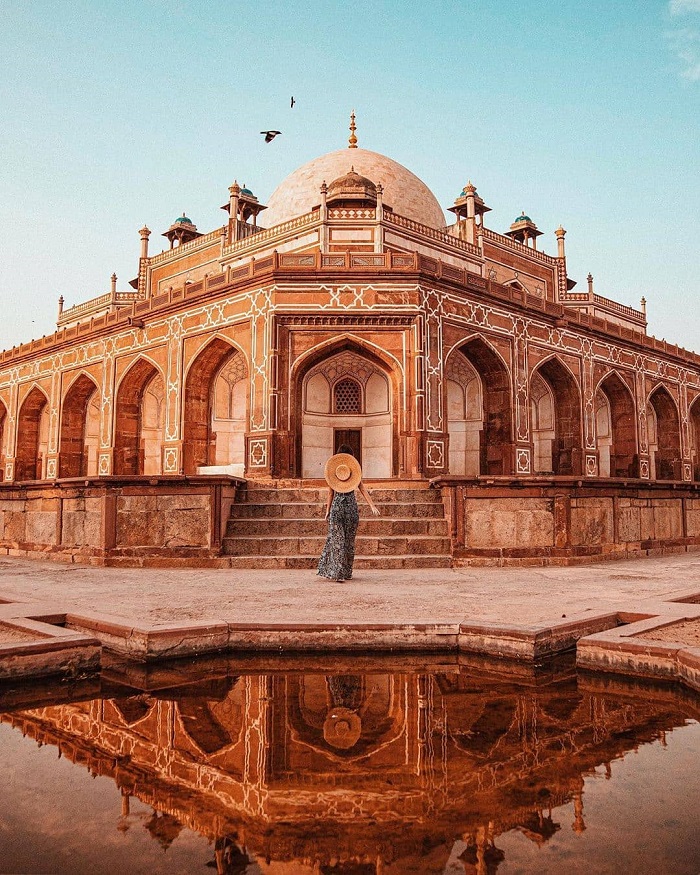
The building was built between 1572 and 1576 under the direction of Queen Hamida Baba Begum to honor her husband, Emperor Humayun. The building has a blend of Persian and Mughal features, creating a template for subsequent Mughal architecture, culminating in the Taj Mahal in Agra.
The large garden is divided into four areas, separated by surrounding moats. The main mausoleum is 47 m high, consisting of 2 floors, the 8 m high top dome is paved with white marble while the rest is built of red sandstone. The mausoleum was calculated according to strict rules of Islamic geometry with an emphasis on the number 8. However, the garden required a large sum of money to maintain, plus the relocation of the Mughal capital from Delhi to Agra resulted in the tomb being abandoned and turned into ruins.
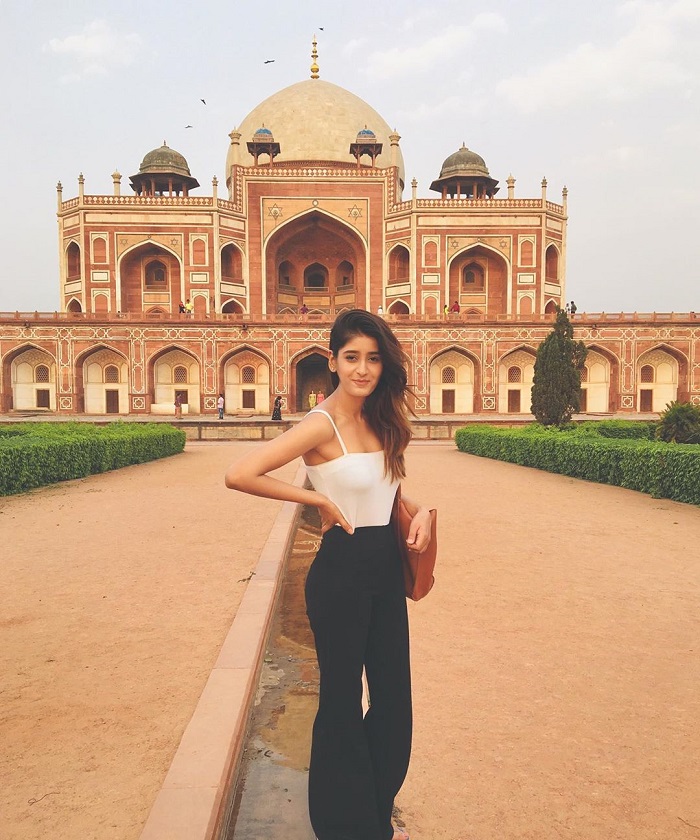
The turning point came to Humayun’s Tomb when UNESCO recognized this place as a World Cultural Heritage site in 1993. The mausoleum was also restored to its original state through funding from the Aga Khan Trust for Culture. In September 2013, after two centuries of neglect, Humayun’s Tomb was opened to visitors and once again entered the list of “The most beautiful structures in the world”.

- Address: Mathura Rd, New Delhi, Delhi 110013.
- Nearest station: About 1.5 km from Jangpura station. Or you can also take a bus about 20 minutes to Dargah Hazrat Nizamuddin. It is only a 10-minute walk from the mausoleum.
- Entrance fee: The entrance fee is 500 rupees, if you bring a camera, you will be charged an additional 25 rupees.
- Opening hours: Daily, from 6am to 6pm
- Note: You can also visit Isa Khan’s Tomb, located right next to the entrance of Humayun’s Tomb. The entrance fee is included in the ticket price of Humayun’s Tomb.
Swaminarayan Akshardham
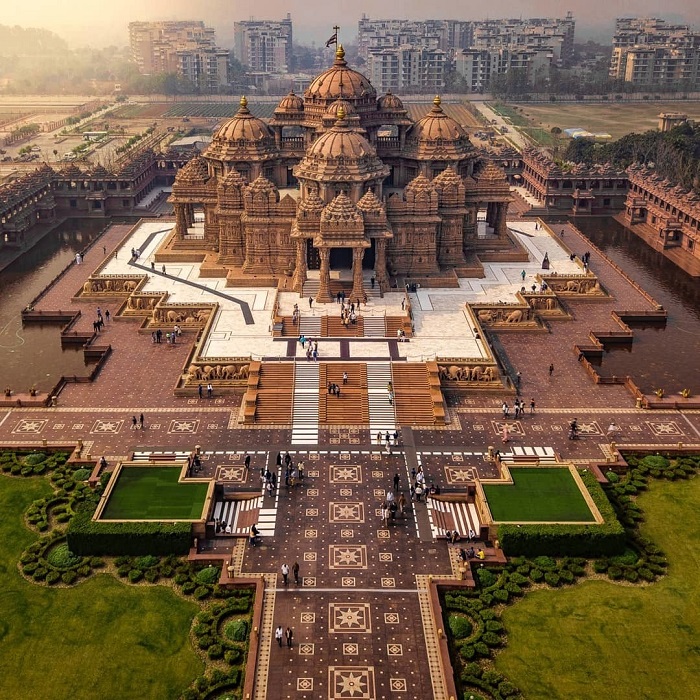
The temple was designed by architect Vivendva Sompura based on sketches by Hindu cleric Pramukh Swani Mahajaj. After 5 years of construction, the temple was inaugurated by Indian President APJ Abdul Kalam on November 6, 2005. It can be said that this is the most massive stone sculpture of India in this day and age, expressing the ultimate splendor of civilization.
The main temple (main hall) is a masterpiece of pink stone and white marble 141 feet high, 316 feet wide, 30 feet long, with 234 ornately decorated pillars, 20,000 sculptures and figures of gods and deities, and 11 huge tall domes. Inside is an 11-foot tall golden statue of the Hindu Bhagwan Swaminarayan. In addition, there are many other stone shrines illustrating the life of the Hindu leader (including an exhibition hall, a 2000-inch screen cinema and a gallery).
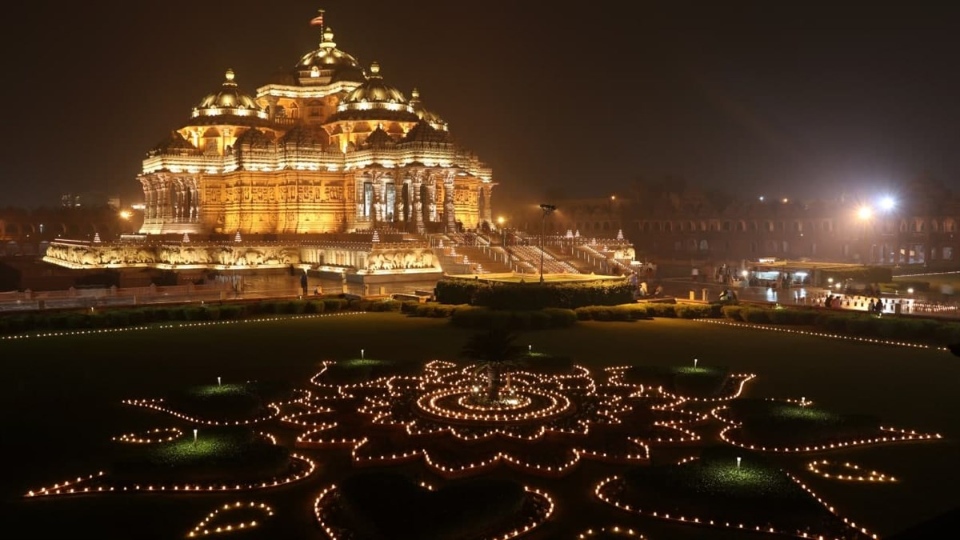
- Address: Noida Mor, Pandav Nagar, New Delhi, Delhi 110092.
- Nearest station: 5 min walk from Akshardham station.
- Entrance fee: Free. Tickets to see the light and sound show are 80 rupees for adults (from 12 years old and above), 50 rupees for children from 4 to 11 years old, free for children under 4 years old.
- Opening hours: From 9:30 am to 6:30 pm from Tuesday to Sunday. Closed on Monday.
Note:
- There is a light and sound concert in the temple after sunset. You should arrive before 5pm because there is still a queue.
- You should dress modestly, politely, covering your shoulders, chest, navel, biceps and knees. The temple also offers sarong rental (deposit 100 rupees).
- You will have to go through a security check before entering the temple. Do not bring any items inside, except wallets, bags, shoes, belts, passports, money, jewelry, baby food, drinking water, coats. Photography is also not allowed. In the temple, there is a photography service of 100 rupees / photo.
Qutub Minar Complex

The complex includes the following works:
- Qutub Minar: The most famous structure. The tower is 72.5 m high, once the tallest tower in the world at the time it was built (1199 – 1230) by order of King Qutb-ud-din Aybak. The tower is intricately carved and still retains its beauty to this day.
- Iron Pillar: Located in the middle of the mosque, the 7 m high iron pillar was erected by Chandragupta II Vikramaditya in 400 AD. After 1,600 years, the iron column is still intact with time.
- Ala-i-Minar: Ala-ud-din-Khilji planned to build a second tower as tall as Qutub Minar, but when the tower was 24.5 m high, he passed away so this tower is still unfinished.
- Ala-i-Darwaza: The square domed building that was once the entrance to the mosque is now stuck behind the tower.
- Tomb of Imam Zamin: Located outside the complex, next to Ala-i-Darzawa, the octagonal mausoleum of a Turk.
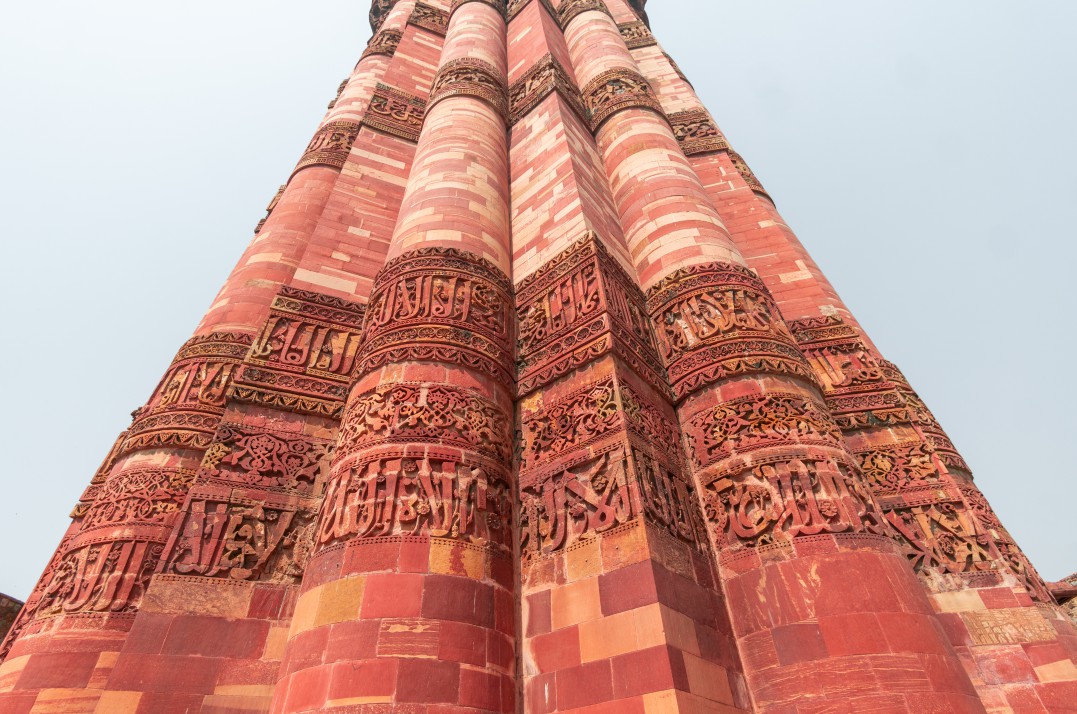

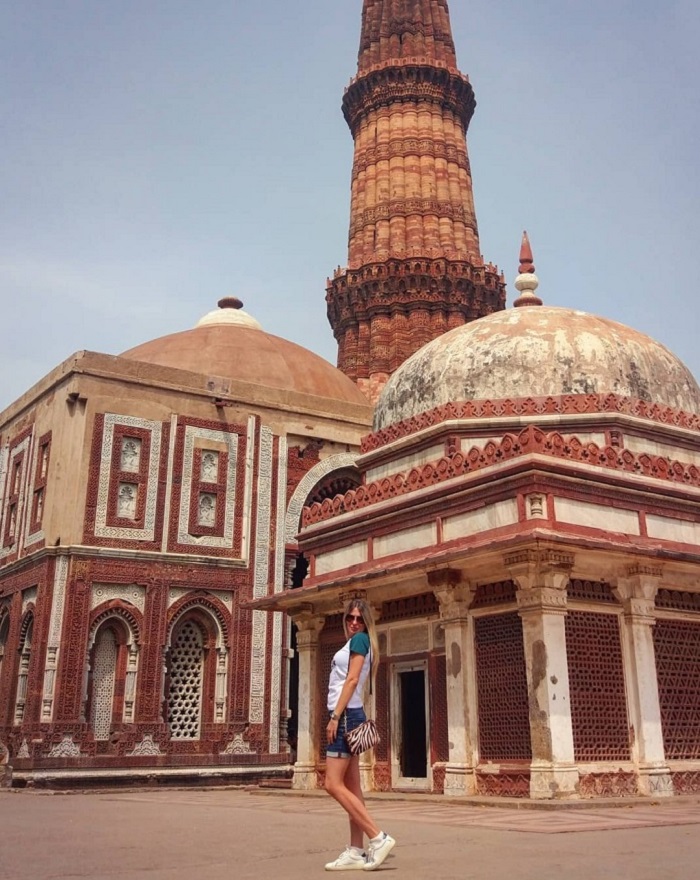
- Address: Mehrauli, New Delhi, Delhi 110030.
- Nearest station: A 5-minute rickshaw ride from Qutub Minar station.
- Entrance fee: 500 rupees.
- Opening hours: From 10 am to 6 pm on weekdays.
Gurudwara Bangla Sahib
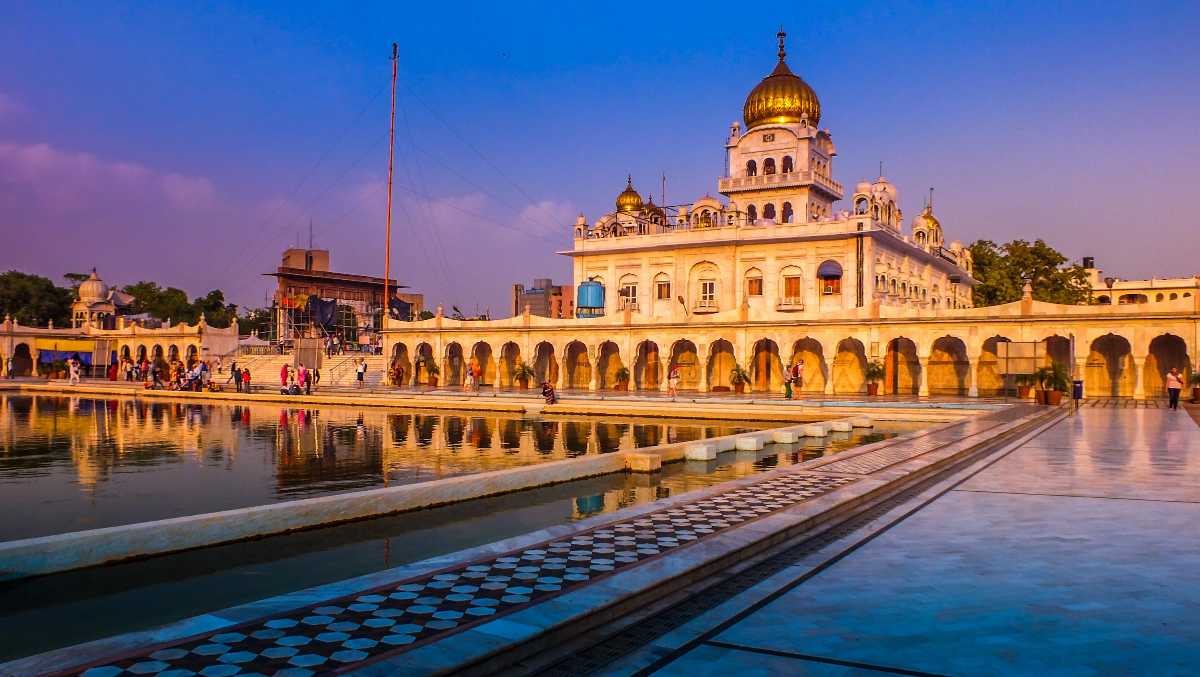
The temple solemnly commemorates Guru Har Krishan Ji, the 8th guru of Sikhism. Originating from Guru Nanak Dev Ji in the early 16th century, Sikhism is considered a relatively young religion in India. Sikhs practice a simple, genuine lifestyle, which includes pure vegetarianism, prayer, and service to others. From morning until nightfall, the Gurudwara, the Sikh temple, are open for devotees to come to worship the Almighty as well as to serve and help others.
In addition, this place is also famous for providing more than 2,000 meals a day for the poor. You should also visit the kitchen to observe the process of preparing meals, very interesting.
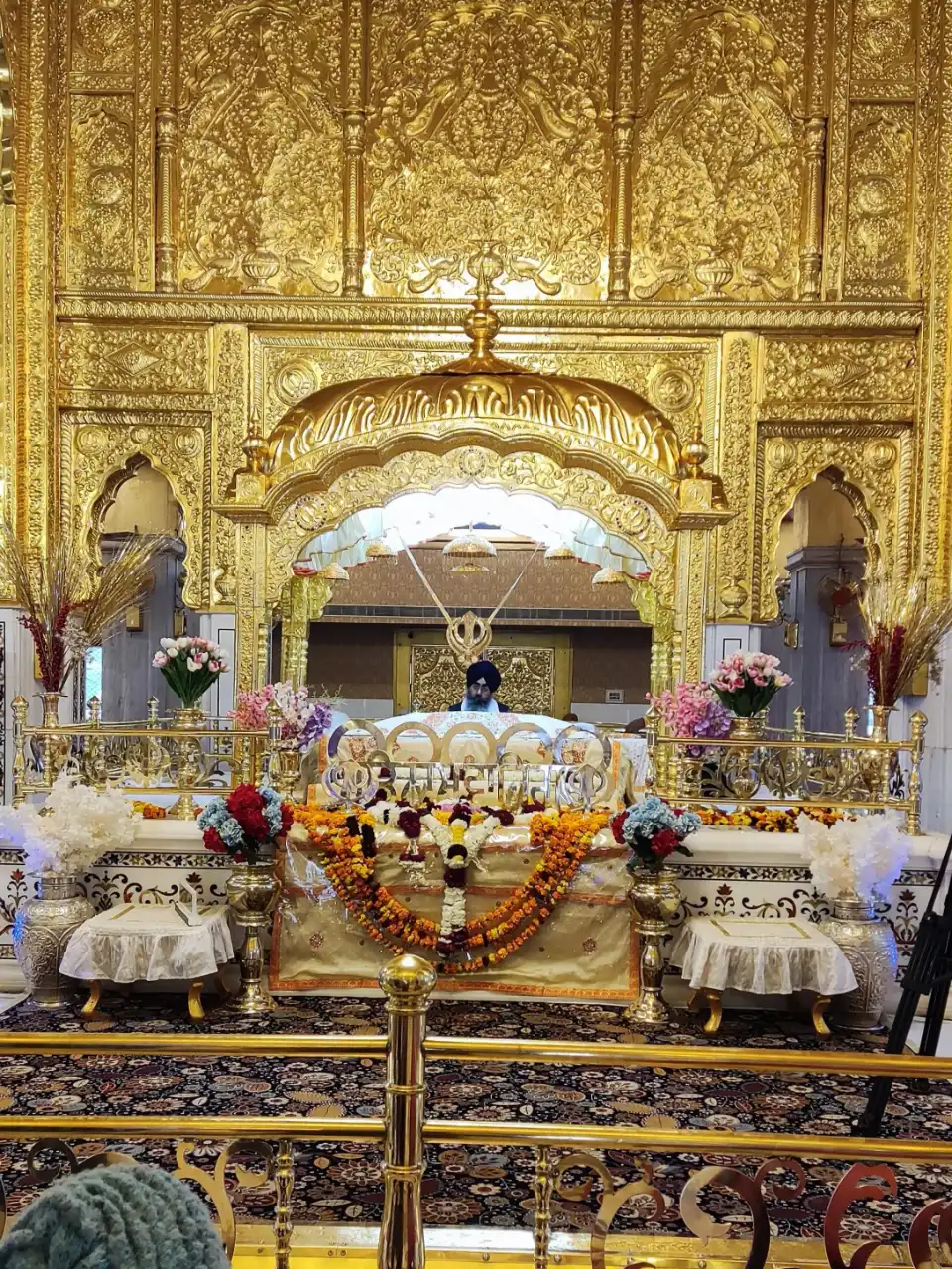
At first, I was mesmerized by the picture and then decided to check out this place. Thought it would shimmer like a palace, like Arksadam. But when I got there, it was a bit… normal. Actually the temple is not special but the experience inside the temple is very special, anyone who enters can get a piece of toffee or something sweet at the gate, wash their hands and feet before entering, ah, also have to wear a hat.
Then when you enter the temple you will be impressed by the big hall, people do worship there all the time, reading the Koran and praying to Allah. I also tried going to the 2nd and 3rd floor of the temple and found that it was almost built for people to sit there to pray, nothing more. The same goes for the corridors on both sides.
- Address: Ashoka Road, Connaught Place, New Delhi, Delhi 110001.
- Nearest station: 400m from Shivaji Stadium station.
- Entrance fee: Free.
- Opening hours: Every day.
Lotus Temple (Baháʼí House of Worship)
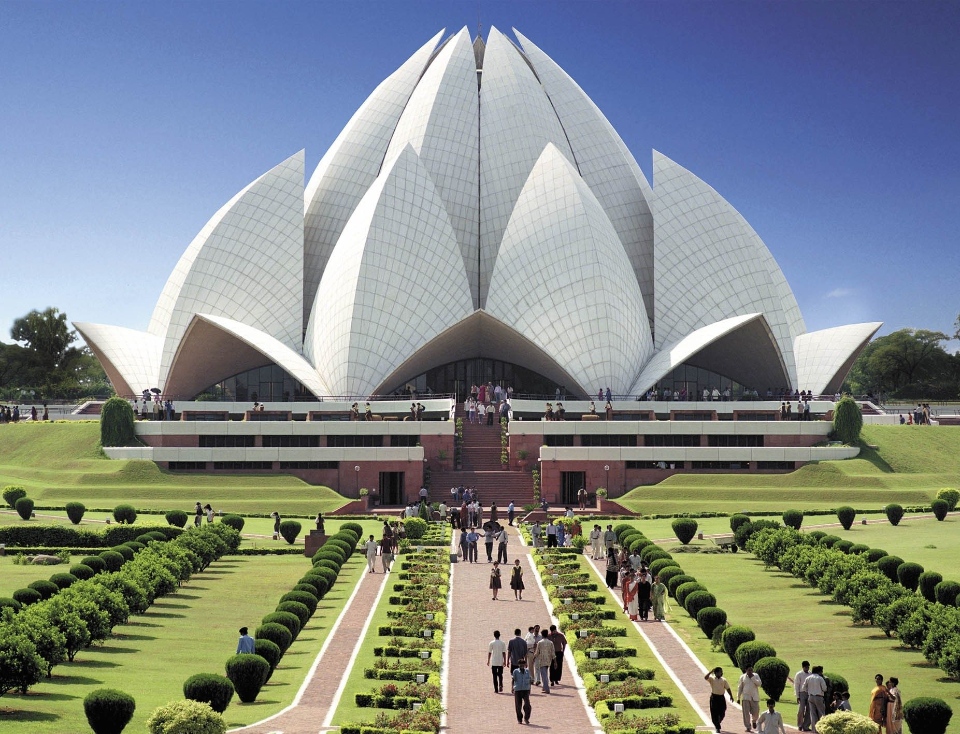
The temple is also known as Lotus temple due to its shape like a blooming lotus. This is the place to celebrate the rituals of Bahai, a modern religion that was just introduced to India in the 19th century. This architectural masterpiece was designed by architect Fariborz Sahba, an Iranian-Canadian, design and construct for 10 years. The temple is 35m high, has an area of about 105,000 m2, can accommodate 2,500 people. As the name suggests, here, lotus flowers are shown in a variety of ways, lotus petals are stylized as corridor arches, patterns on the doors. The nine reflecting pools on the outside of the building also simulate lotus leaves. Only one year after its appearance, in 1987, Bahai Temple was ranked third among the largest and unique structures in the world.
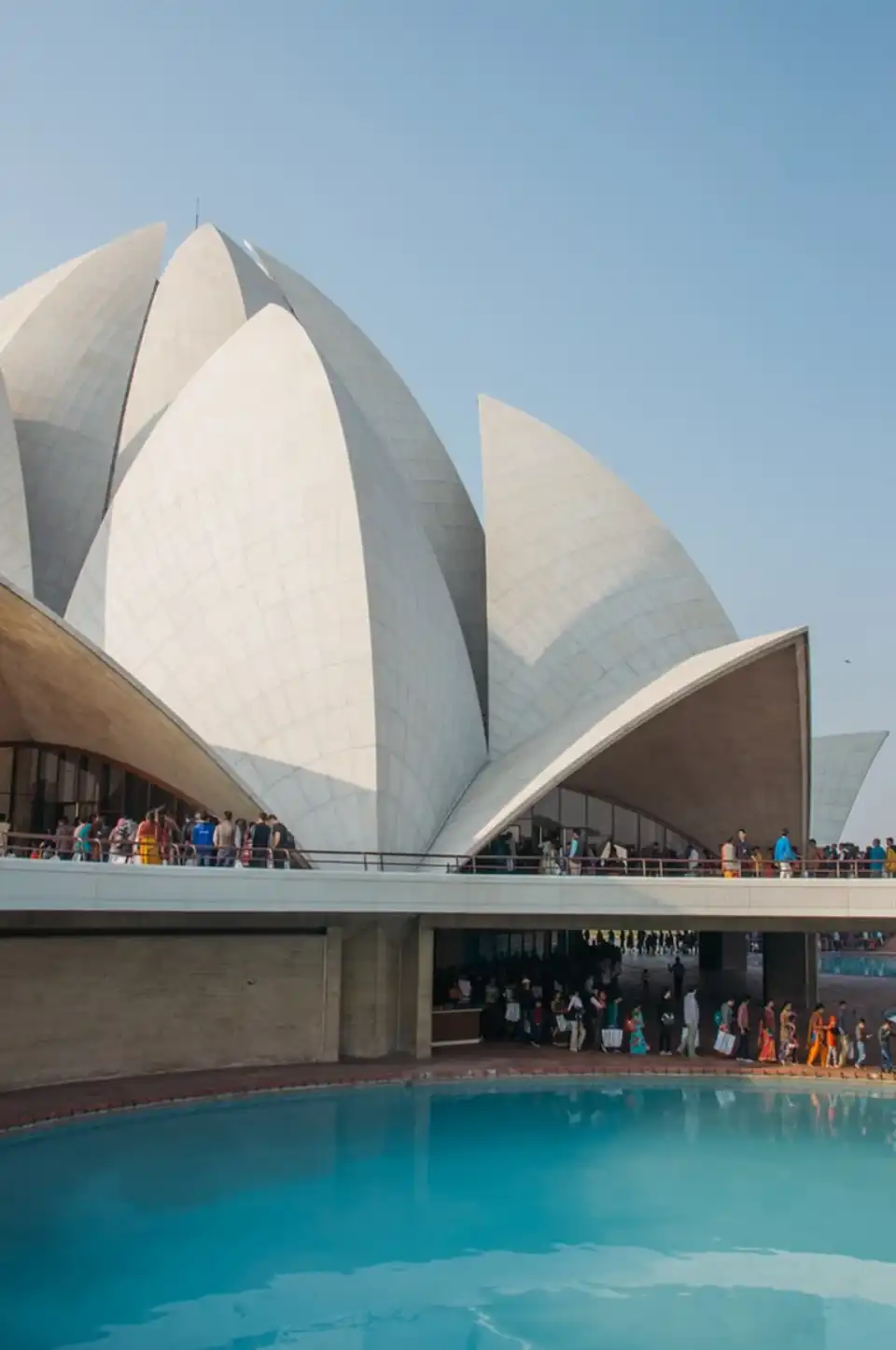
The Baháʼí are known for managing picturesque gardens and building beautiful places of worship. On a 26-acre site, Lotus Temple welcomes visitors of any and all religions. The design of the temple is fascinating whether you are photographing the lotus structure from the outside or experiencing the interior of the concrete dome.
- Address: Lotus Temple Rd, Bahapur, Shambhu Dayal Bagh, Kalkaji, New Delhi, Delhi 110019.
- Nearest station: 500 meters from Kalkaji Mandir station.
- Entrance fee: Free.
- Opening hours: From 9am to 5:30pm from Tuesday to Sunday. Closed on Monday.
- Note: Photography is not allowed in the temple.
India Gate

Impressive with its 42-meter-high arch, India Gate was built in 1921 to honor Indian soldiers who died in World War I and the Afghan war. India Gate is also the gate that opens the Rajpath road leading directly to the official residence of the President of India. At certain times of the year, visitors can visit the Mughal garden located on the grounds of the mansion.
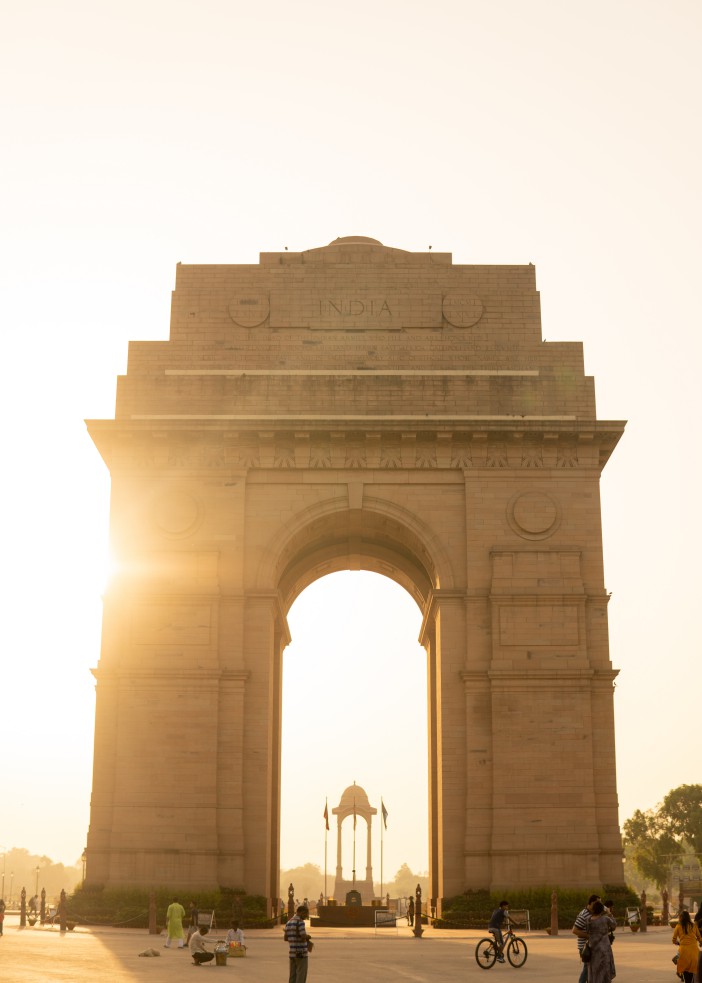
- Address: Rajpath, India Gate, New Delhi, Delhi 110001.
- Nearest station: Central Secretariat.
- Entrance fee: Free.
- Opening hours: Closes at 9pm.
Lodhi Gardens

When I first learned about this garden, I thought it was just a park like many other parks, there was not much to see, but when I went inside, I was really impressed because there are many architectural works mixed with trees looks very beautiful, and it turns out that this is a relic of a very old dynasty, from the 15th century – Lodhi.
The attraction here in my opinion is the small attractions right in the Lodhi garden complex. Mainly the tombs and shrines of the Lodhi dynasty. The characteristic of these works is the domes that look from afar like the domes of churches in the Mediterranean region, reminding me of the churches in Santorini with the blue color while here is brown yellow.
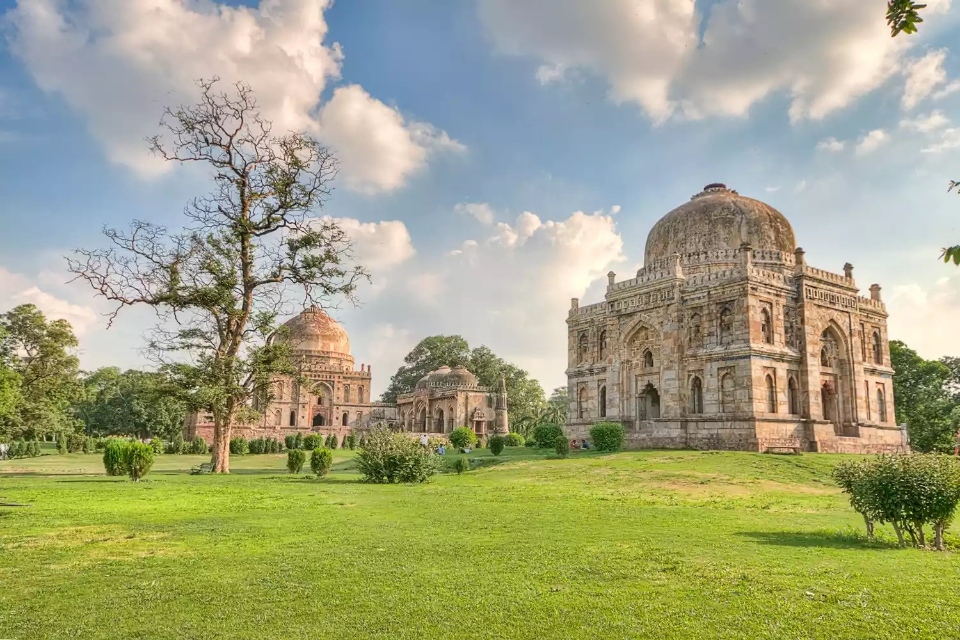
- Entrance fee: Free. So it’s worth the trip!
- Best time to come: I went in the morning and to be honest, the photo was too bright, because it was a bit against the sun. However, the morning is not crowded at all, and you are ready to exercise.
- My rating: 4.5 stars. It is very beautiful indeed, and even more beautiful if you wear an Indian dress and take pictures with these sites, like the friend who accompanied me.
National Museum
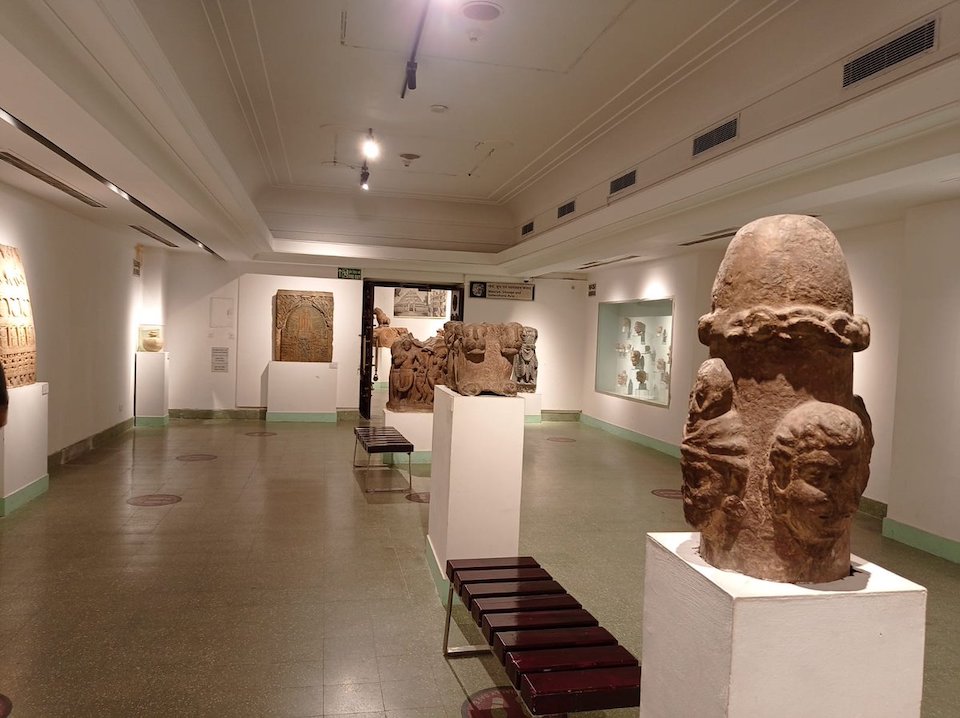
The National Museum in New Delhi is home to more than 2 million ancient artifacts. From archaeological discoveries to photography never seen from decades ago, the National Museum is the perfect way to experience Indian culture of the past century.
- Address: Janpath Road, Rajpath Area, Central Secretariat, New Delhi, Delhi 110011, India
- Hours: The museum is open from Tuesday to Sunday from 6am – 10pm. Closed on Mondays
Rashtrapati Bhavan

Also known as the Presidential Palace, Rashtrapati Bhavan is actually the official residence of the president of India. First completed in 1929, you can tour the main building, the museum on site, and the beautiful gardens on the 330-acre property.
- Address: Rashtrapati Bhawan, President’s Estate, New Delhi, Delhi 110004, India
- Hours: 9:30 AM–5:30 PM/Saturday, Sunday: Closed
Purana Qila
It is also an ancient fortress in the Old Delhi, so if you have been to the Red fort, you should visit here. The impression to me is that it is not the ruined fortress but the smooth green lawn that is cool to the eyes, proving the high level of horticulture of the Indians. And the ruined fortress looks like a good background for you to take pictures. But my friends and I have seen many of these fortresses, so we are not interested anymore.
I am especially interested in the hexagonal building that looks a lot like a mausoleum in the middle of this smooth green lawn. However, when I and my friend arrived, we couldn’t take a picture in the front, but had to go around the back because of a pair of young men and women standing in front of us.
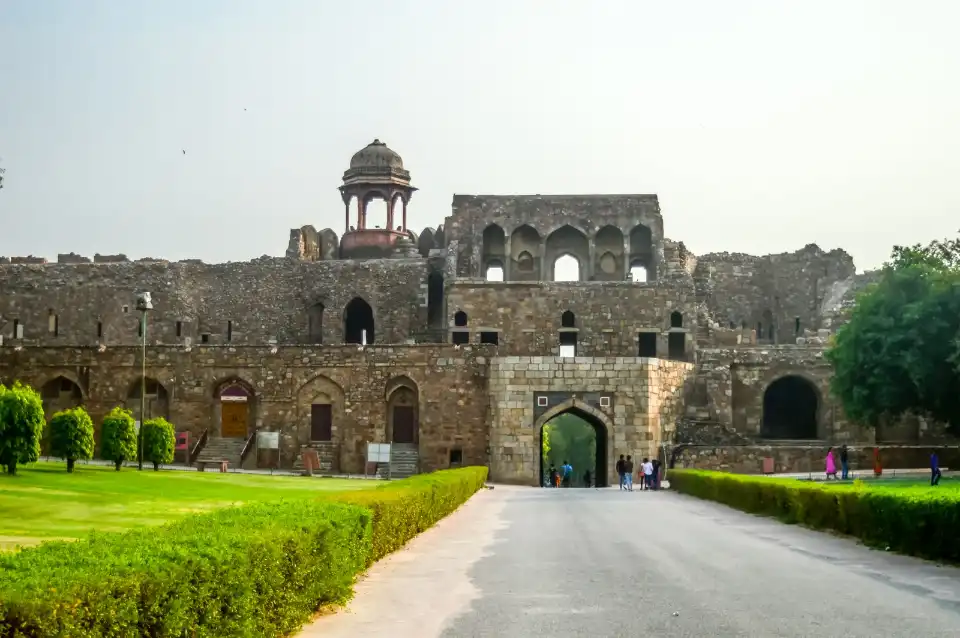
- Address: Mathura Rd, Near Delhi Zoo, New Delhi, Delhi 110003, India
Hours: 7 AM–5 PM - Admission: 200 Rupees for foreigners. 20 Rupees for Indians (the same price as everywhere else)
- Mt rating: 4.0. Because beyond of the lawn and the hexagonal house, everything else is pretty normal.
Agrasen ki Baoli
Since I went to Jodhpur and saw a beautiful well there, I dreamed with my friend to visit the well known as one of the top 10 most beautiful wells in India, which is Agrasen ki Baoli. If you have ever seen photos of terraced wells in India, you will be impressed by the extremely sophisticated architecture of these wells. When I didn’t come, I looked at the picture and said why it was so beautiful, still full of poetry when there were birds flying by. But when I got there, I was… a bit disappointed. Actually it is much smaller than the well in Jodhpur.

After all, the most beautiful terraced well in my mind right now is still the well in Jodhpur.
- Address: J6GG+C2F, Hailey Road, KG Marg, near Diwanchand Imaging Centre, New Delhi, Delhi 110001, India
- Hours: 9 AM–5:30 PM
- Entrance fee: 5 rupees, is a tip for the housekeepers there, but it is free on the website of the Ministry of Culture and Tourism.
Safdarjung Tomb
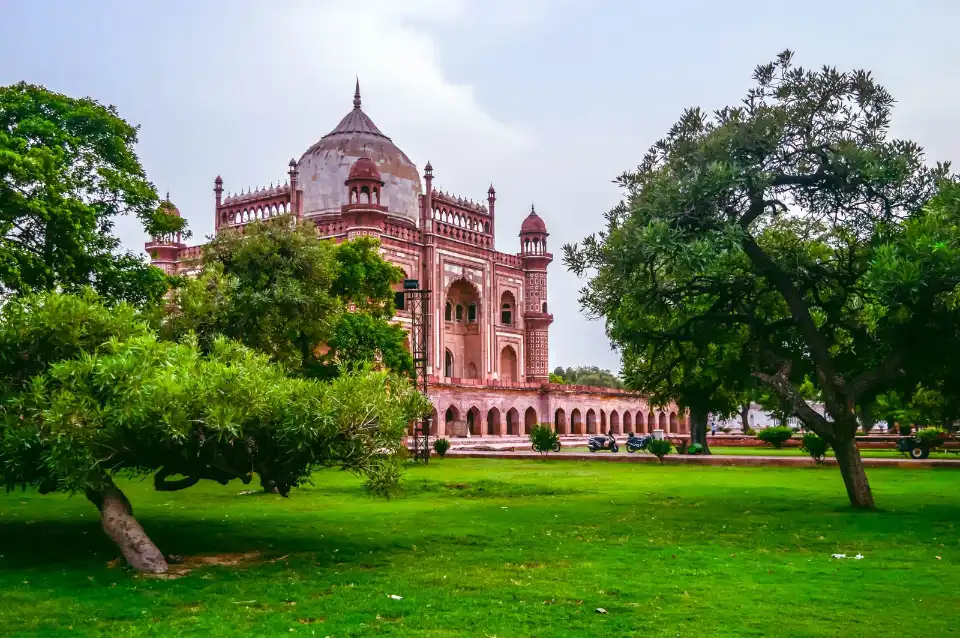
To tell the truth, sometimes I don’t distinguish between Humayun and Safdarjung because both are mausoleums, both built from red sandstone, both have the symmetrical architecture of the Muslim and the dome, are square shape. Also, both have gardens and fountains. Bravo! like twins, only the older Humayun was born a century before the younger brother. For Safdarjung, this is the mausoleum of a prime minister, not a king, but it’s so majestic!
- Address: Airforce Golf Course, Delhi Race Club, New Delhi, Delhi 110021, India
- Hours: 7 AM–5 PM
Admission: 100 Rupees, very cheap price. - Rating: 4.0. Pretty but no different from Humayun Tomb.
ISKCON Temple
Seems to be the only temple I’ve been to in New Delhi that isn’t a mosque. I went to this temple with me just to admire the tower that looks like a beautiful bamboo shoot. That’s all. But the temple is not crowded and there are many reliefs and statues about Krishna, so you can stop by to see. In general, going to New Delhi is quite a long time because there are many things to explore. You try to arrange at least 3 days to see it to the fullest.
- Ticket price: Free.
- Rating 3.5.
Yamuna Ghat
Yamuna is the name of a very famous river in India: the Ganges River, people come here early in the morning to rent a boat out in the middle of the Ganges to feed the birds.
But when I arrived, I probably got lost, so I got lost in the place where people cremated the dead along the river.
For those who do not know, cremating the dead and scattering ashes into the sacred Ganges River is a cultural feature of the Hindus, who believe that after death they will reach Nirvana to escape reincarnation.
What to eat?
If you ignore the colorful, flavorful dishes, you miss a very important part of Delhi’s cultural identity. From the kitchens of upmarket hotels in South Delhi to the sidewalk eateries, called aloo chaat, in the Connaught Place area, the cuisine here is enough to “beat” even the most demanding diners. Here are the most typical dishes that you cannot miss in Delhi:
Dahi bhalla
Dahi bhalla (also known as dahi vada), consists of yoghurt (dahi) and fried golden lentil cakes (vada), served with pomegranate seeds, raisins, and a typical Indian mango chutney. Dahi bhalla has a special aroma, slightly spicy and sweet, very suitable for hot summer days. Recommended place to try: Natural Store is located near the station on Chandni Chowk Road.
Rabri faluda
This dessert is made from noodles (called faluda) and traditional monosodium glutamate (called rabri, which is a mixture of milk, cream, sugar and cardamom). Usually, rabri is drizzled over the faluda along with whipped cream. When eating, you mix the ingredients well, the taste is cool and fragrant. If you come here in the right season, rabri faluda is also served with a special mango wine. Recommended place to try: Hiani di Hatti store near Fatehpuri Masjid.
Paratha
This is a doughnut made from flour, with a mixture of local vegetables, served with mango chutney, sabri and some raw vegetables. Paratha feels soft and crispy when first eaten, while the filling is pleasantly chewy. If you like the novelty, you can order paratha with khurchan ice cream, Old Delhi’s specialty made from fresh milk. Place to visit: Pandit Babu Ram Devi Dayal shop on Parathewali Gali small street.
Jalebi
A beautiful orange pastry made from a fermented dough, fried golden in butter, before drizzled with sugar syrup. Jalebi cakes are shaped like noodles that stick together. Place to visit: If you have tasted jalebi before, you should still try this dish at Chandni Chowk. Here, people always sell fresh, crispy, chewy and hot cakes.
Papri chaat
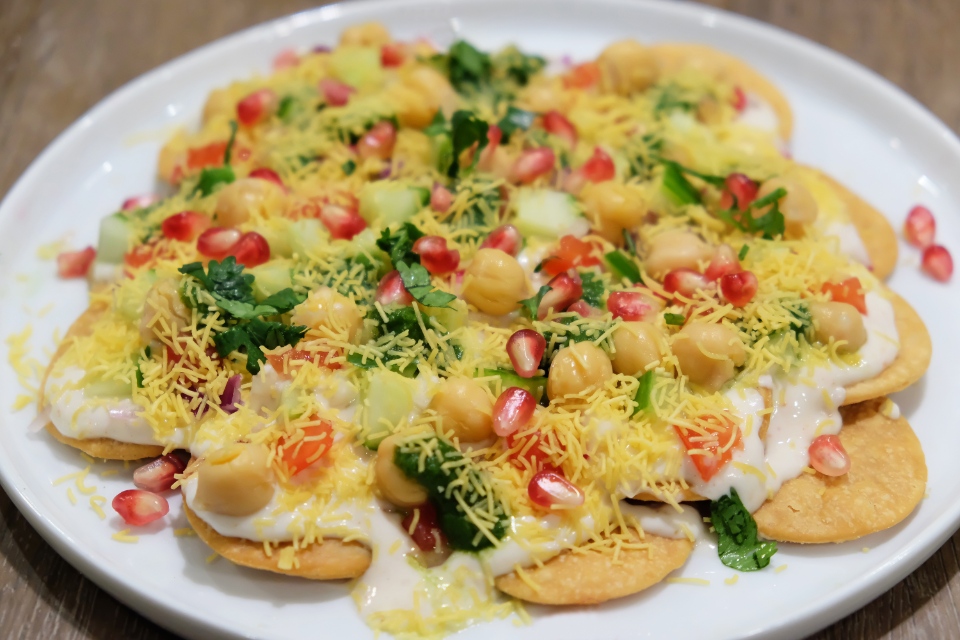
The best junk food in India. Crispy waffles (papri) are used as the base, topped with tomatoes, peas, chaat masala, yogurt, tamarind, mango chutney, pomegranate seeds and sev, or fried flour. Papri chaat is a great combination of spicy, sweet, fatty, aromatic and crispy. Places to visit: Famous shops for papri chaat are Askok Chaat Bhandar in Sitaram Bazar, near Chawri Bazar, or Haldiram on Chandni Chowk.
Bedmi-aloo and nagori-halwa
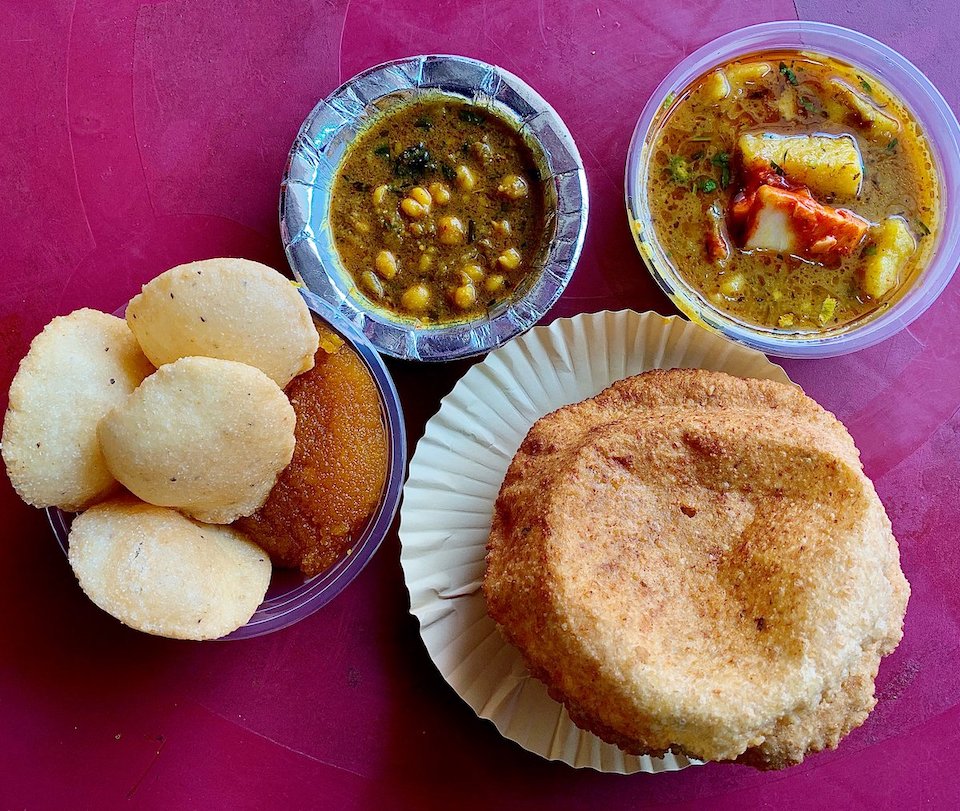
The familiar breakfast of Delhi people is bedmi-aloo and nagori-halwa, two dishes that always go hand in hand. Bedmi-aloo is a type of bread made from fried wheat flour resembling puri, often served with very spicy condiments, aloo sabzi or potato curry. Meanwhile, nagori is a sweet dish, suitable when eaten with suji halwa, a kind of sweet porridge. Place to visit: You can find these two famous breakfast dishes pass down to the five-generation Shyam Sweets shop, located on Chawri Bazar Road.
Mutton burra kebab
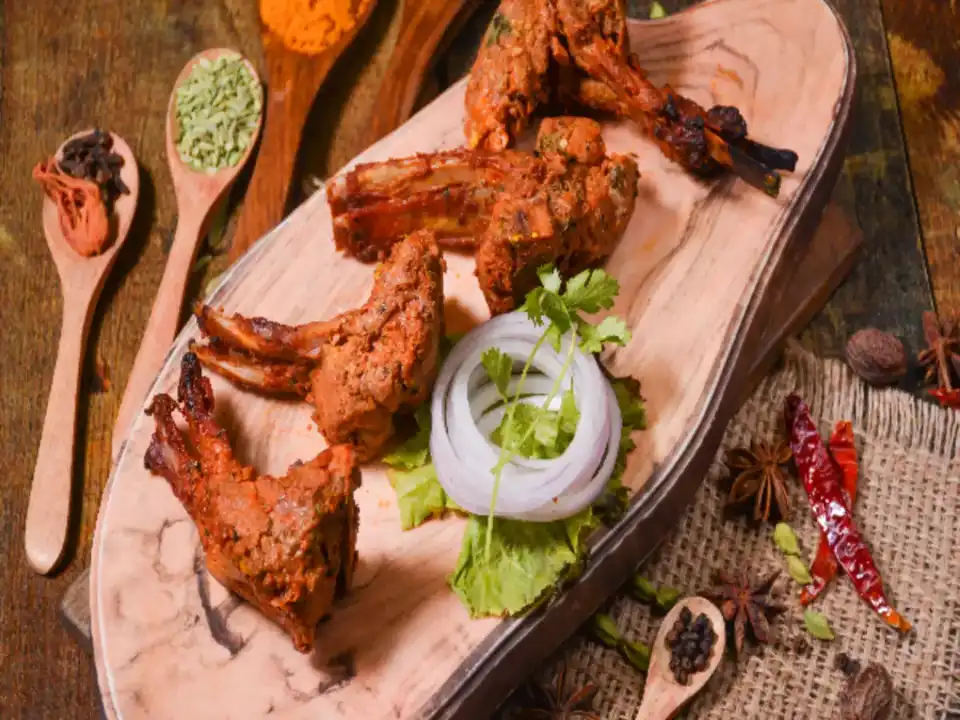
This is a charcoal-grilled lamb dish, usually restaurants grill mutton bura right in front of the shop. Roast lamb has a very strange taste, a little aromatic, a little pungent and a little smoky. Served with mutton bura is tandoori roti sauce. Where to find: Karim Hotel, near Jama Masjid, is the perfect place to enjoy mutton bura kebab, prepared according to the Indian Mughal royal method.
Kebab (Skewered meat)
Also considered as one of the delicious and attractive dishes in New Delhi you must definitely enjoy. The dish is like grilled skewers, using easy-to-find ingredients such as lamb, pork or chicken marinated in spices and then grilled to create a delicious, extremely attractive flavor.
Samosa

Samosas is a delicious street food in Delhi that is loved by many people. With delicious taste, eye-catching yellow color creates attractiveness and attractiveness to diners. To create a more attractive taste, when eating many people also enjoy Samosas along with drinking very delicious Chai tea.
Kulfi
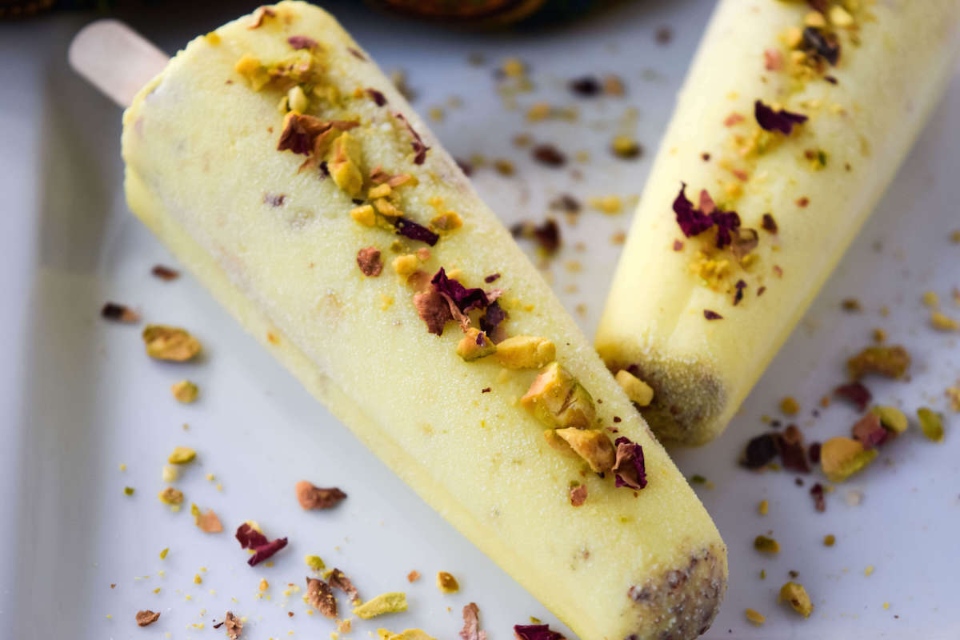
Besides delicious and famous food in New Delhi, Kulfi special ice cream is also street food, delicious and attractive snack in New Delhi which is loved by many people. Kulfi ice cream is also divided into many types of ice cream with diverse flavors, of which the most famous is still the faluda-covered kulfi ice cream which is still the most popular ice cream dish.
Shopping
I have to swear and promise that just going to an Indian market in New Delhi, you will be full of eyes and immersed in a non-stop shopping passion because it has so many items at unbelievable cheap prices. In fact, like buying an Indian shirt or T-shirt, it seems that the material is very cool and also durable. As for the pattern, if you like boho, colorful, you will like alibaba bags, shirts, pants …. in this place. Very bright and lively.
North Delhi
- Chandni Chowk: Chandni Chowk means “Moonlight Square”. Built in the 17th century by Emperor Shah Jahan, this is one of the oldest and busiest markets in Delhi. Open from 10am to 5pm, Monday to Saturday.
- Main Bazaar: From Connaught Place, go through Chelmesford Road, you will see the market located on the street of the same name. Open from 10am to 9pm, Tuesday to Sunday.
- Karol Bagh: The market sells spices and kitchen utensils. Open from 10am to 7pm, Tuesday to Sunday.
Downtown Delhi
- Janpath: The market attracts tourists by woolen textiles, bronzes, clothes, Indian belts… Open from 10:30 am to 7 pm on weekdays.
- Khadi Gramodyog Bhawan: The market specializes in selling Indian-style clothes, spices, soaps, henna ink, handmade leather goods, etc. Open from 10:30 am to 7 pm on weekdays.
- Palika Bazaar: The market mainly deals in electronics. Open from 11am to 7pm weekdays.
Where to stay?
Delhi is full of accommodation, from budget guesthouses to lavish international hotels. Reservations for luxury hotels can be made at travel desks in airports and train stations. Self-sufficient tourists who want to save will have to hunt around the city on their own. There are many websites/apps to help you book rooms with a variety of prices and locations, visitors should book in advance on the web.
If you are planning to stay in New Delhi, hotels in the Paharganj area are a good choice. In Old Delhi, most tourists choose hotels near Red Fort.
If you want to go to New Delhi and then find a room, don’t believe offers, taxi drivers or people who say there are no rooms available at the hotel you intend to book and avoid the recommended places in the area called Karol Bagh.
Below we recommend more best budget, mid-range and upscale hotels with good ratings and reviews you can refer to.
- ibis New Delhi Aerocity – An Accor Brand (Agoda, Booking)
- Radisson Blu Plaza Delhi Airport (Agoda, Booking)
- The Lalit New Delhi (Agoda, Booking)
- Roseate House (Agoda, Booking)
- The Park New Delhi (Agoda, Booking)
- Hotel Novotel New Delhi Aerocity (Agoda, Booking)
- Taj Palace, New Delhi (Agoda, Booking)
- Radisson Blu Marina Connaught Place (Agoda, Booking)
- Hyatt Regency Delhi (Agoda, Booking)

Check out more top and best hotels in Delhi on Agoda.com or Booking.com
Travel cost
This is always difficult because everyone’s commuting habits are different, especially in a city like Delhi where there is so much to see and do. Assuming you stay in Delhi for three days, then a daily budget of about INR 2,500-3,000/person should be enough. This takes into account your accommodation, transportation, entrance fees, meals, drinks, and pocket wifi rental.
Some tips before you go
- In India, mainly rupees and dollars are used. You should change money in Vietnam in dollars first, then you will use USD to exchange directly into Rupees in this country, it will be more beneficial because the rate of rupees in Vietnam is not high.
- Because India is a predominantly Hindu and Buddhist country with quite strict dogmas, so you need to be very careful when traveling here such as not wearing too revealing clothes, anything that needs to be used with a hand (such as giving a gift, a cup of tea or important documents) must be used with the right hand, the left hand is mainly used for hygiene by the Indians.
- If you are a woman, you should not travel to Delhi alone
- Don’t show excessive affection in public
- Always have a tissue ready when traveling because people here often use water to clean
- If you are a guest at a meal, do not ask for more food and should leave some on the plate
- Rent a pocket wifi transmitter: Having a strong and stable wifi connection is very important when traveling these days. It allows you to do research, navigate, convert currencies, and google good restaurants near you, too.
- Beware of street food: Have you heard of the phenomenon known as “Delhi belly”? It’s traveler’s diarrhea while traveling in India. It’s a very real thing and something you should take care of, especially if you enjoy eating street food. Maybe the culprit is hand-made street ice cream. The “Delhi belly” can be the thing that ruins your trip, so here are the most important things to remember:
- Find popular stalls. The more famous the stall, the cleaner and safer the food.
- Avoid foods and drinks with water. Water is the leading cause of “Delhi belly,” so it’s best to avoid dishes made with water or sauces. Ice is always inevitable, and any fruit or vegetable washed with unfiltered water should be handled with care. If possible, go to stalls that prepare foods with distilled water.
- Safer fried or baked or grilled foods. Heat kills bacteria, so fried or baked foods are generally safer to eat. This also applies to beverages. Hot drinks like chai tea are safer because the water used to make them has been boiled.
- Rent a car or take a guided tour: The attractions in Delhi are spread out and not all are located right next to the metro station. The Delhi metro is very convenient but if you don’t have a lot of time in the city, then you might consider renting a private car, even if it’s just for a day.
- Bring the right adapter: India has a Type C, Type D or Type M power outlet, so be sure to bring the right adapter for your device. The voltage is 230V and the standard frequency is 50Hz.
Some best day tours, trips, activities and transfer services, tickets in, from and to New Delhi you can refer to
- Taj Mahal and Agra Fort Day Tour from Delhi
- Taj Mahal and Agra Private Day Tour by Express Train from Delhi
- 3D2N Golden Triangle Tour from Delhi
- Private Sunrise Tour Of Taj Mahal and Agra Fort from Delhi
- New & Old Delhi Day Tour
- [Klook Exclusive] Taj Mahal Private Day Tour from Delhi with One Way Airport Transfer
- Delhi Private Car Charter
- Private Tour Of Taj Mahal + Agra Fort From Agra
- 4D3N Delhi, Agra, Jaipur Private Tour with Ranthambhore Tiger Safari from Delhi
- Delhi Best of Monuments Half Day Tour
- Jaipur Day Tour from Delhi By Express Train
- Agra, Mathura, and Vrindavan Day Tour from Delhi via Luxury Bus
- 2D1N Golden Triangle Tour from Delhi
- Jaipur Private Day Tour from Delhi
- 2D Delhi and Agra Combo Private Tour
- Private City Transfers between Delhi and Himachal Pradesh/Punjab
- Old Delhi Bazaar Walking Tour
- Masterji Kee Haveli Half Day Tour
- Old Delhi (Shahjahanabad) Morning Cycling Tour
Read more India guide here.































![10 best airports in Asia in 2016 [RANKED] kuala-lumpur-international-airport-best airports in asia in 2016 by skytrax ratings](https://livingnomads.com/wp-content/uploads/2016/08/29/kuala-lumpur-international-airport-best-airports-in-asia-in-2016-by-skytrax-ratings-218x150.jpg)








